If you’re a marketer, you can’t help but hear about HubSpot’s massive growth.
They have a traffic rank of #5 in the world… in the online marketing tech space.

This doesn’t include websites they’ve built to build their community and fill the top of their sales funnel.
They are a major player in the SMB software market, growing revenue 49% in the last year, from $181.9M to $271M.
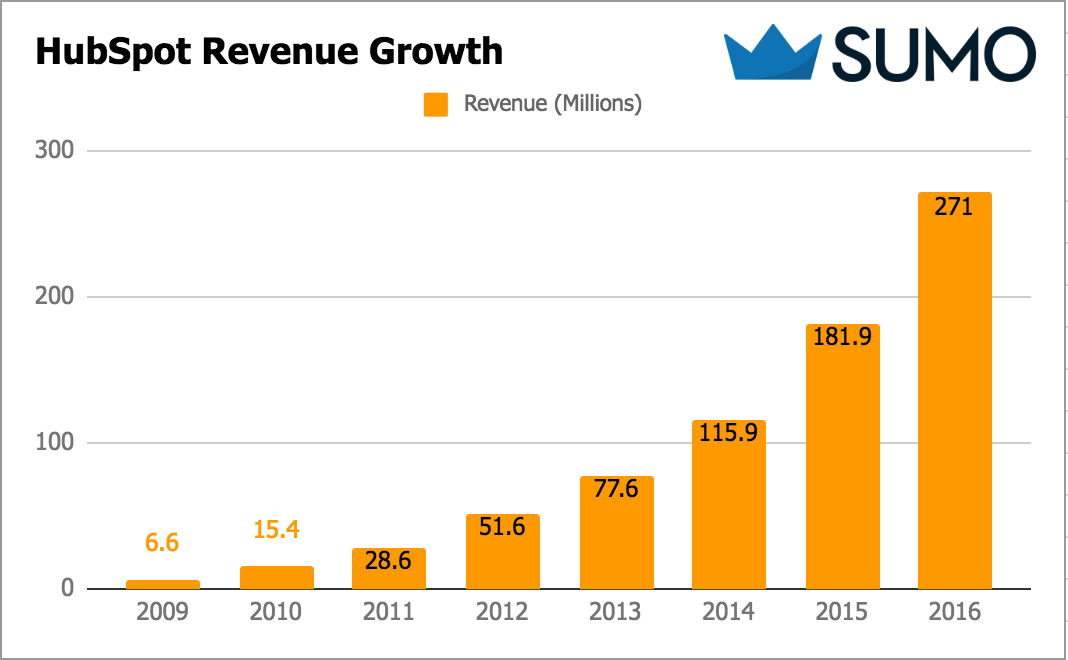
It is my hope in this article to show you what’s truly working online in marketing by giving you a glimpse into the strategies and tactics of one of the marketing and tech industry's biggest players.
What you see below is not conjecture or theory. This is the real facts behind a major tech company, the marketing strategies they use, and the tactics used.
Table of Contents
%(tableofcontents)
Hubspot was founded in 2006 by Brian Halligan and Dharmesh Shah. In 8 years they grew from zero to $100M+ revenue, with an IPO in 2014. Both founders had successful backgrounds in tech before launching HubSpot.

According to their Annual Investors Report, HubSpot has built an audience of over six million people between their blog visitors, Twitter followers, Facebook fans, and LinkedIn connections.
Their large engaged audience is considered to be the largest in the software industry.

HubSpot reported that their subscriptions accounted for 94% of their total revenue in this year so far. Professional services accounted for the other 6% of revenue.
Perhaps best known for their inbound marketing prowess, HubSpot’s rocketship growth trajectory makes them the second fastest SMB software company to ever IPO.
While they have about a dozen sites over the years, it appears that there are 4 critical websites key to HubSpot’s online marketing strategy.
- HubSpot.com
- WebsiteGrader.com
- Inbound.org
- ThinkGrowth.org
I’m going to show you the latest marketing tactics HubSpot are using on those websites right now to grow website traffic and leads into the millions per month.
[Tip #1] The BotBook Content Partnership You Can Use To Amplify Your Website Traffic With Top Industry Players
HubSpot gets their brand in front of other people's audiences by doing content partnerships. One notable example is their Chatfuel content collab.
There are three major elements to their collab with Chatfuel that you should swipe and deploy for your own strategy.
1) Two industry experts = major knowledge advantage.
You could say that Bots are the ‘talk of the town’, and HubSpot took advantage of this by creating a partnership with one of the leading industry experts in this field.
HubSpot and Chatfuel teamed up to create an eBook so hot that it’s hard for me not to immediately download it. 
2) The content piece they created with Chatfuel is offered on Chatfuel’s domain. This gives HubSpot an entirely new audience to be in front of.

3) HubSpot uses a FB bot landing page to deliver the eBook aka BotBook.
Here is what the funnel looks like, it’s pretty ingenious.
This is the FB bot landing page HubSpot and Chatfuel are using:
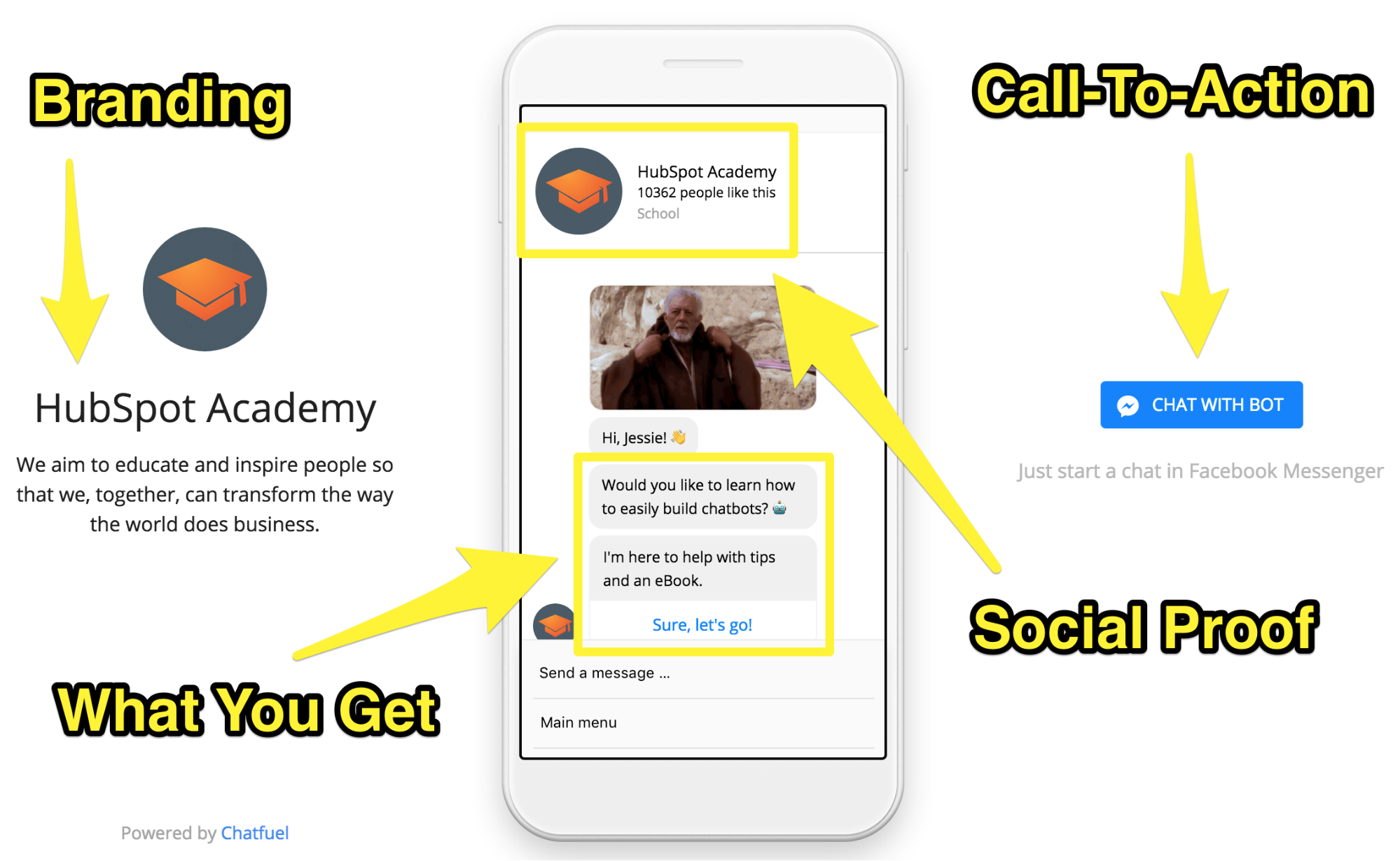
After signing up for the eBook, you get taken to a page where you are guided to click through to your Facebook Messenger as a next step towards accessing the info:
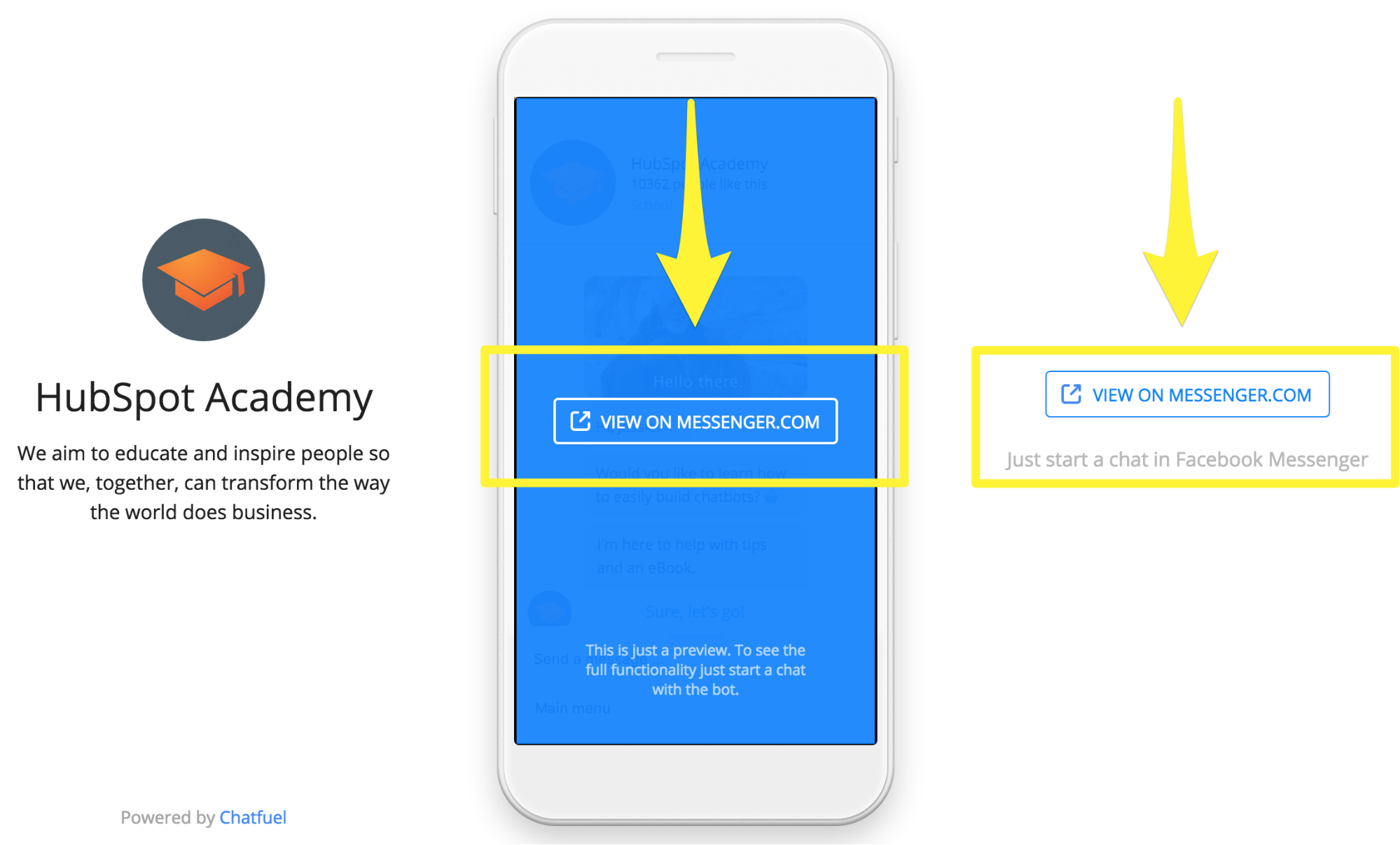
After click through, you are then prompted with a cute GIF and an opt in button:
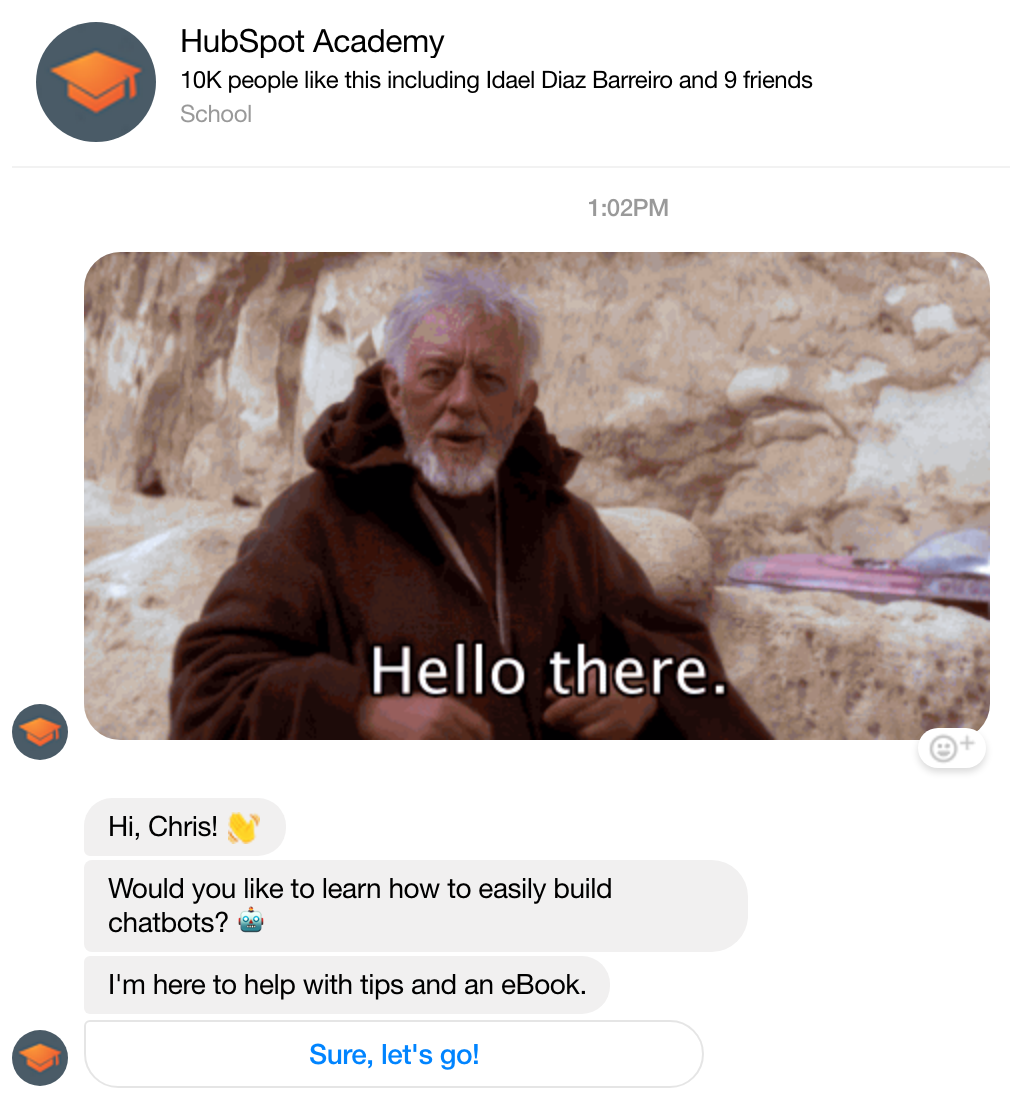
After you opt in via the Bot button (and after HubSpot shares another cute GIF) HubSpot then brilliantly uses the Bot to capture lead information about you:

You are then lead through various questions that HubSpot uses to capture more information about you. HubSpot uses that info later to hyper-target you with more relevant content (as you will see in other tips in this article):

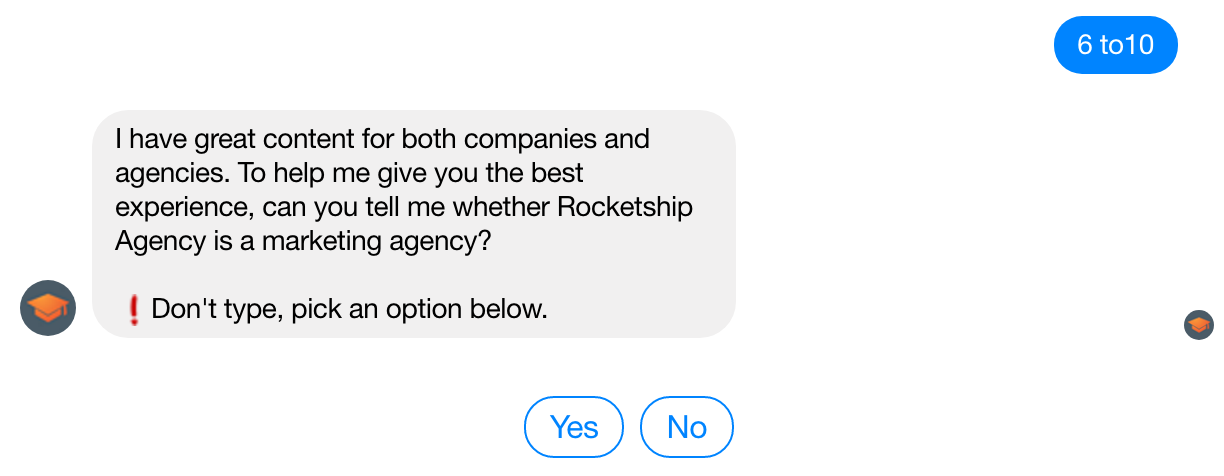
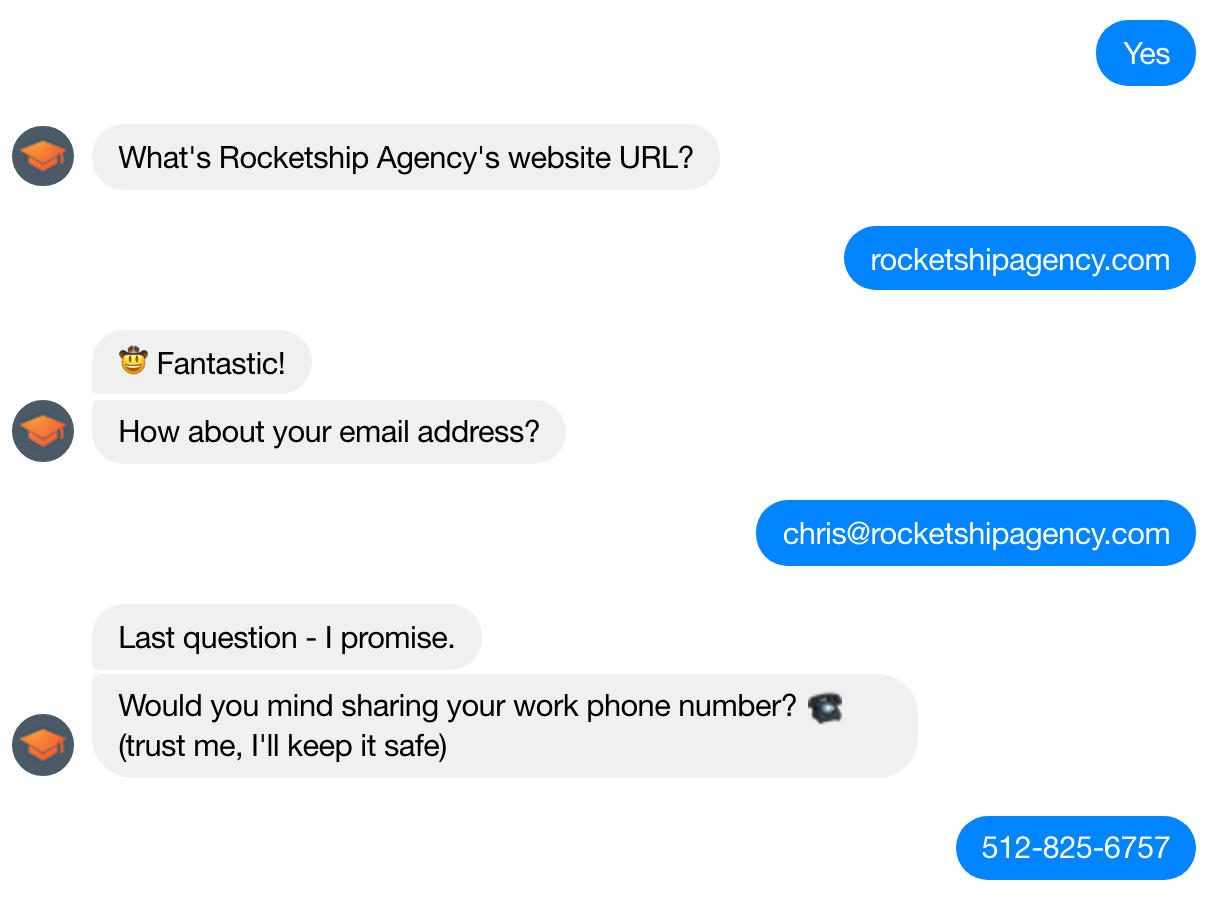

When you click on “Get the free ebook” you are taken to a co-branded HubSpot/Chatfuel landing page that is hosted on HubSpot to read the full HTML version (or download the pdf).
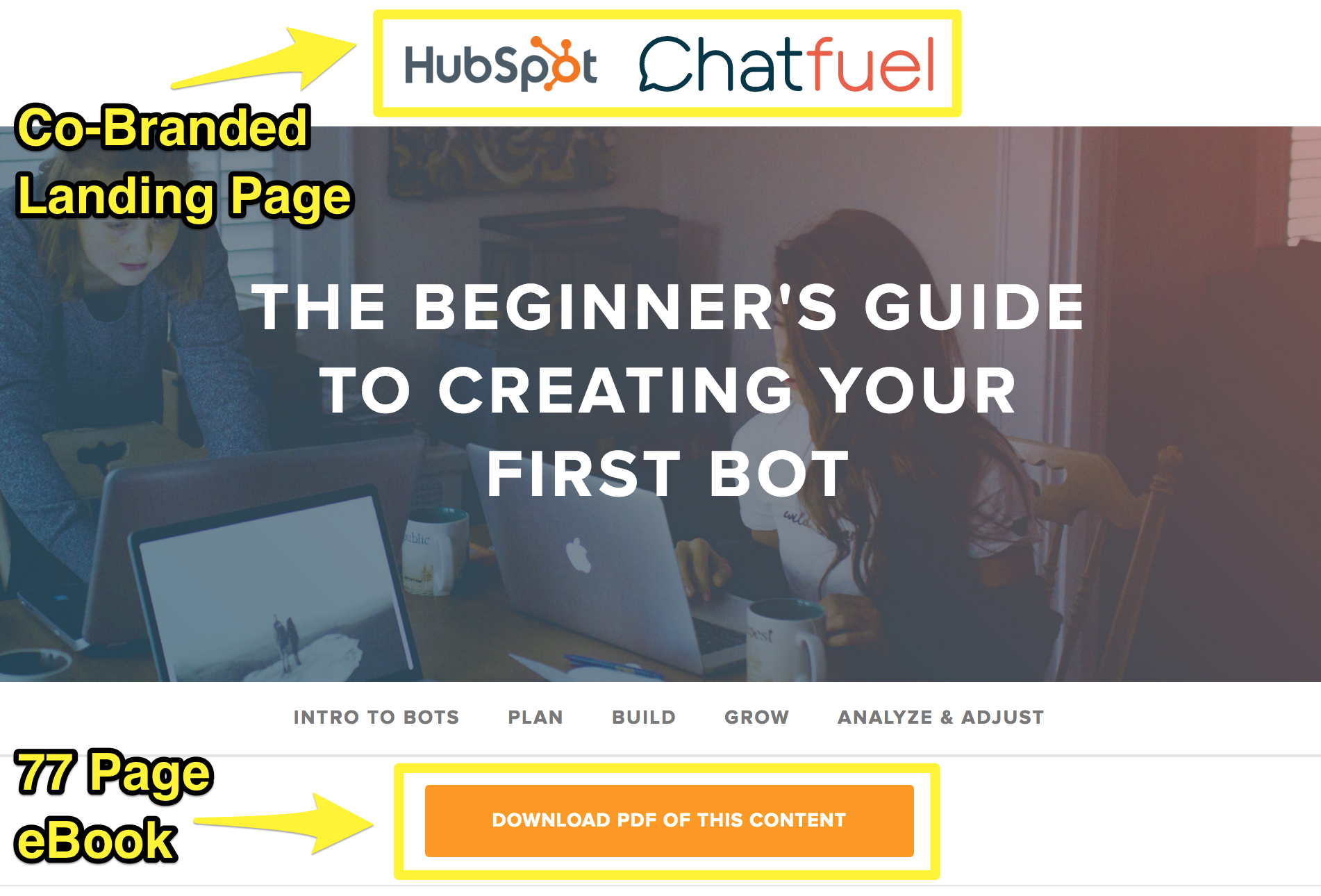
At the very end of the page there are 2 calls-to-action. One that goes to HubSpot’s contact page, and one that goes to Chatfuel’s home page.
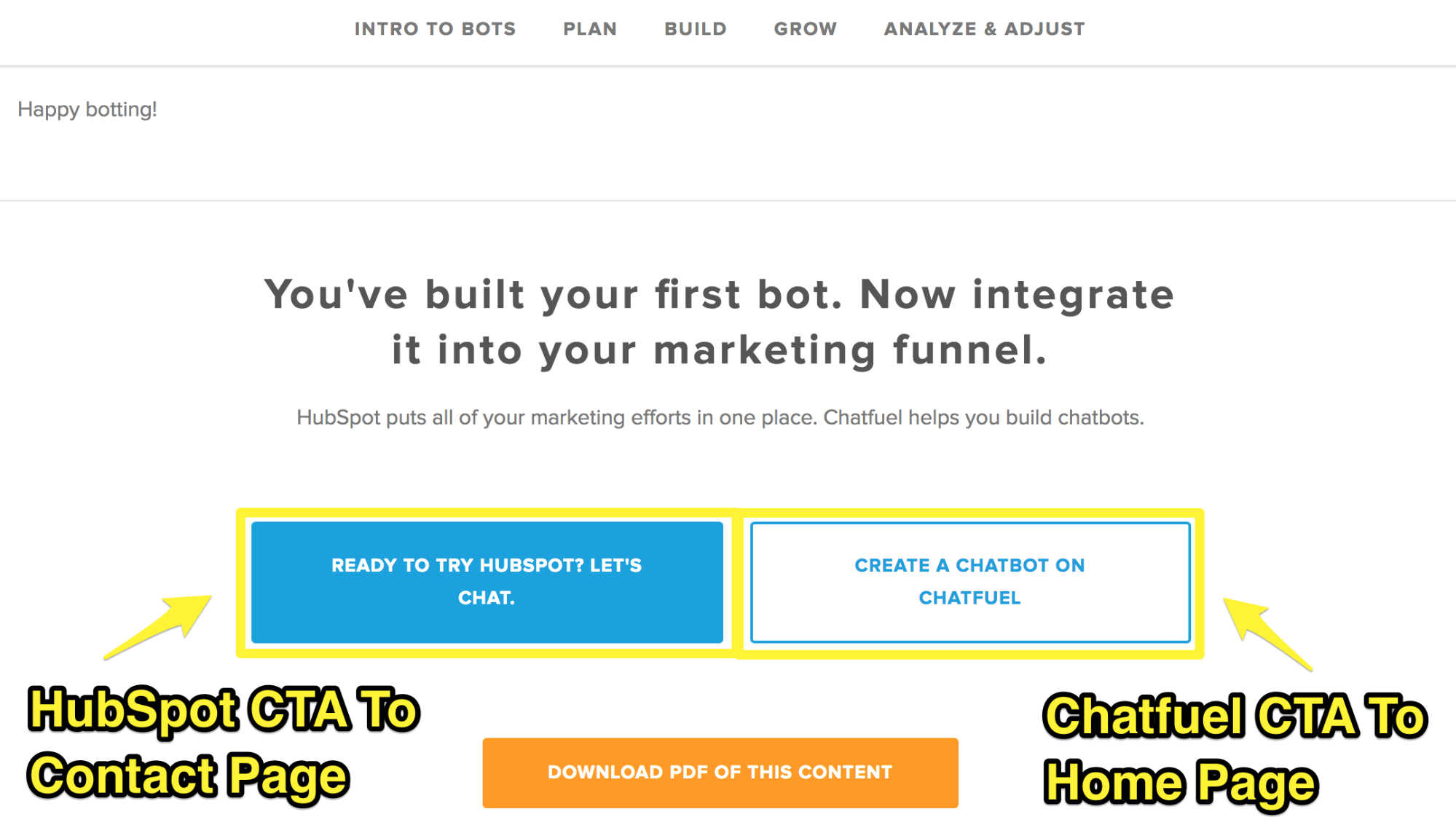
Golden Nugget: To track the amount of traffic going to the Chatfuel home page, HubSpot uses a special tracking URL on the Chatfuel CTA button using the “utm_source” URL parameter.
![]()
Take careful note of how HubSpot tag the end of the URL with “?utm_source=hubspot_ebook.” HubSpot do this so Chatfuel can search for this URL inside their Google Analytics and track the performance of their content collaboration.
5 hours after signing up to get the BotBook, HubSpot then send you a message asking you for permission to send you chapters of the eBook inside your Facebook messenger.

After accepting, HubSpot show you a shocking statistic with an image to prove how important it is for you to learn more about why bots are relevant today so you consume more of their content.
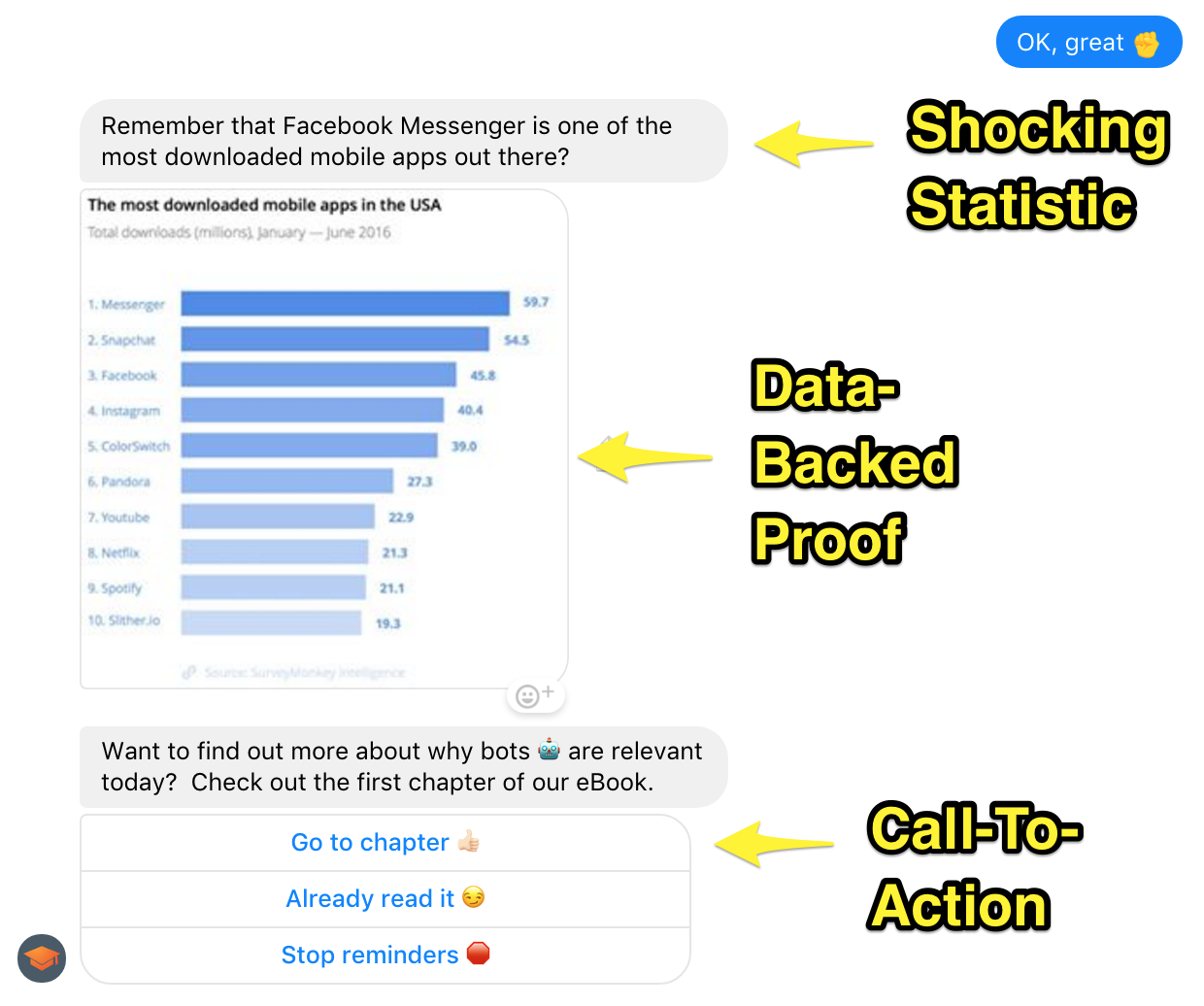
They then start to send you chapter 1 of their eBook (word-for-word as it’s appears on HubSpot’s landing page and inside the pdf).
But they don’t send you huge paragraphs of text, instead they send you bite-sized nuggets of information, just as if you were typing a message to a friend then hitting enter after every thought you have (and they include fun gifs that aren’t on their landing page or pdf).
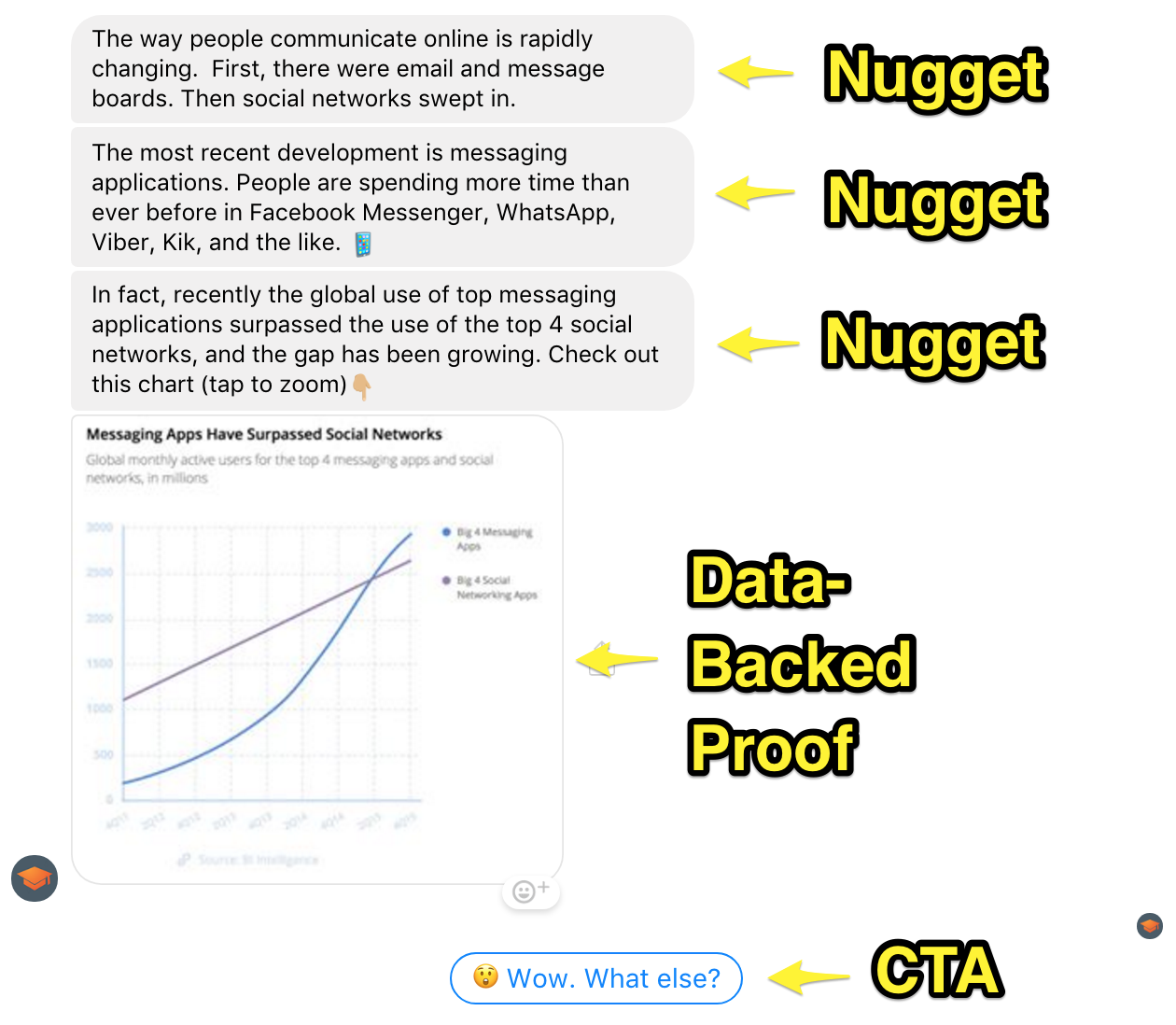
HubSpot even use personalization to take their Bot experience to the next-level. You can’t do this inside a blog article or pdf:
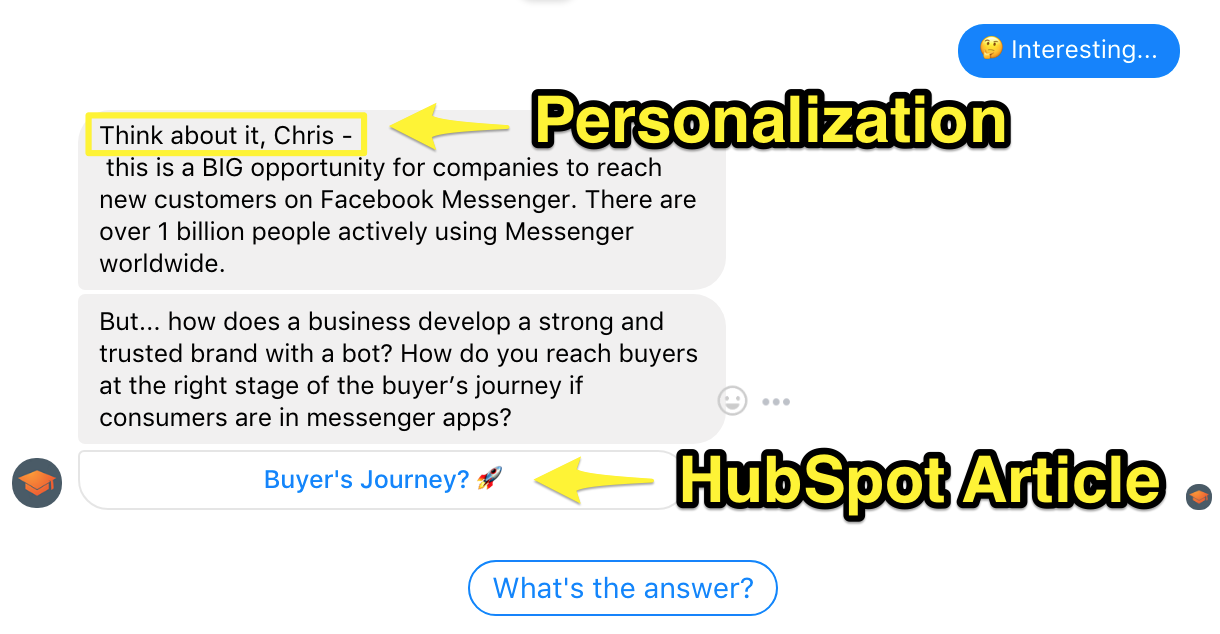
The ingenious part of this whole content partnership, is that this whole eBook is a massive native advertisement for Chatfuel while generating leads that are already starting to know, like and trust HubSpot.
The partnership also positions HubSpot as an expert on a new marketing topic, “chatbot marketing” which is new to most people.
Click here to subscribe to Sumo Bot, and get free access to our #1 growth study.
The takeaway: LOPA = leverage other people’s audiences. Find a top player in a related industry and create a powerhouse partnership by offering a piece of content that your prospects will drool over. Use Facebook bots to then automatically and authentically capture more information about your prospects and deliver the content via the bot.
[Tip #2] The Big 3 Social Media Networks You Need To Promote Your Content On To Get 1 Million Traffic Per Month
Although social traffic is only 2.54% of HubSpot’s total traffic, it accounts for over 1,000,000 traffic per month. The Big 3 social networks you need to focus on for traffic are Facebook, LinkedIn and YouTube (in that order).
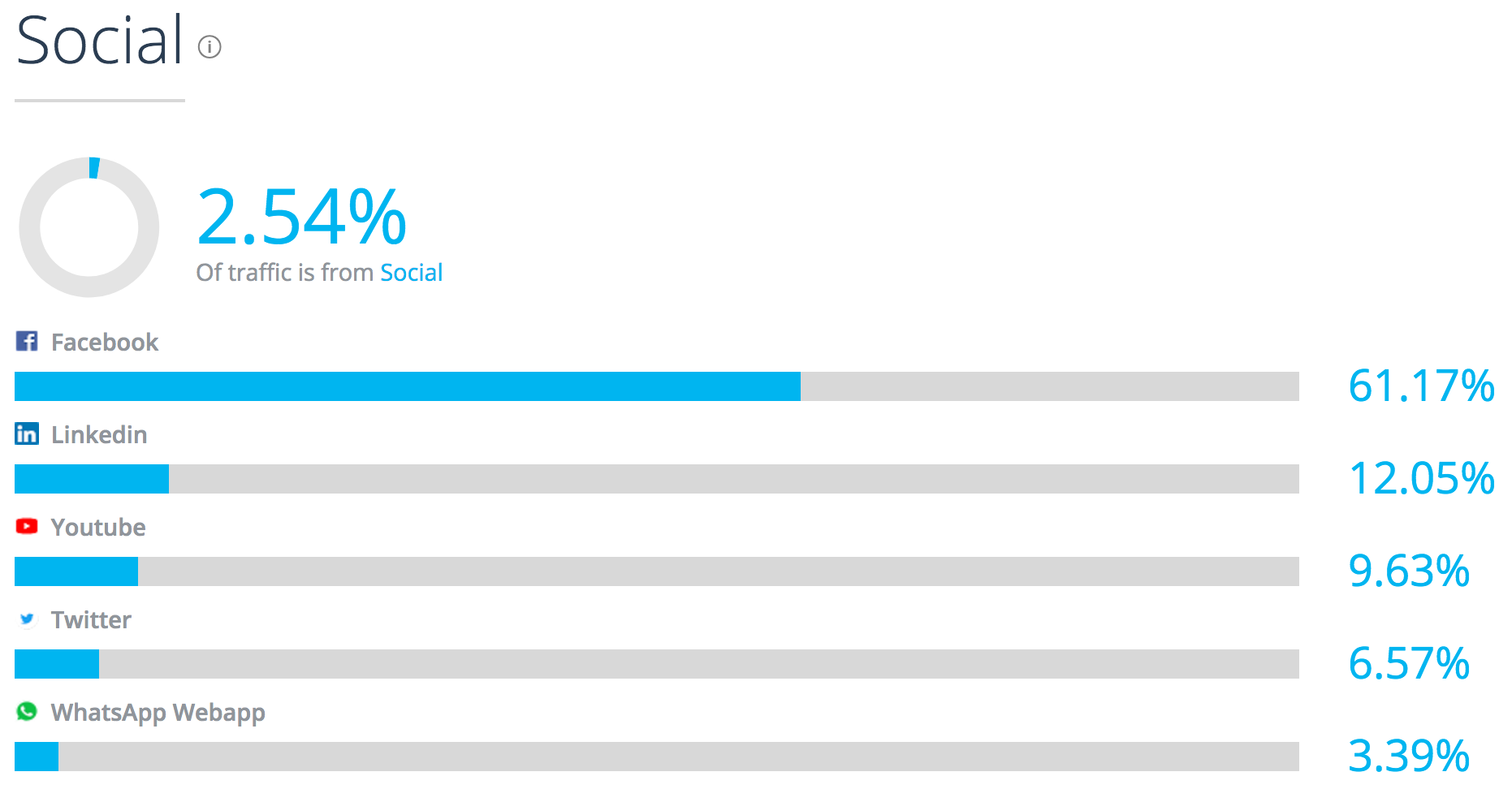
HubSpot’s Facebook video strategy is off-the-charts. Their native videos have incredible view numbers, likes, comments PLUS they provide HubSpot with valuable leads by offering free tools related to their videos in the video comments.
They have successfully turned their Facebook videos into lead magnets, and with the number of views each video gets this strategy is powerful in terms of the number of new leads generated for HubSpot:
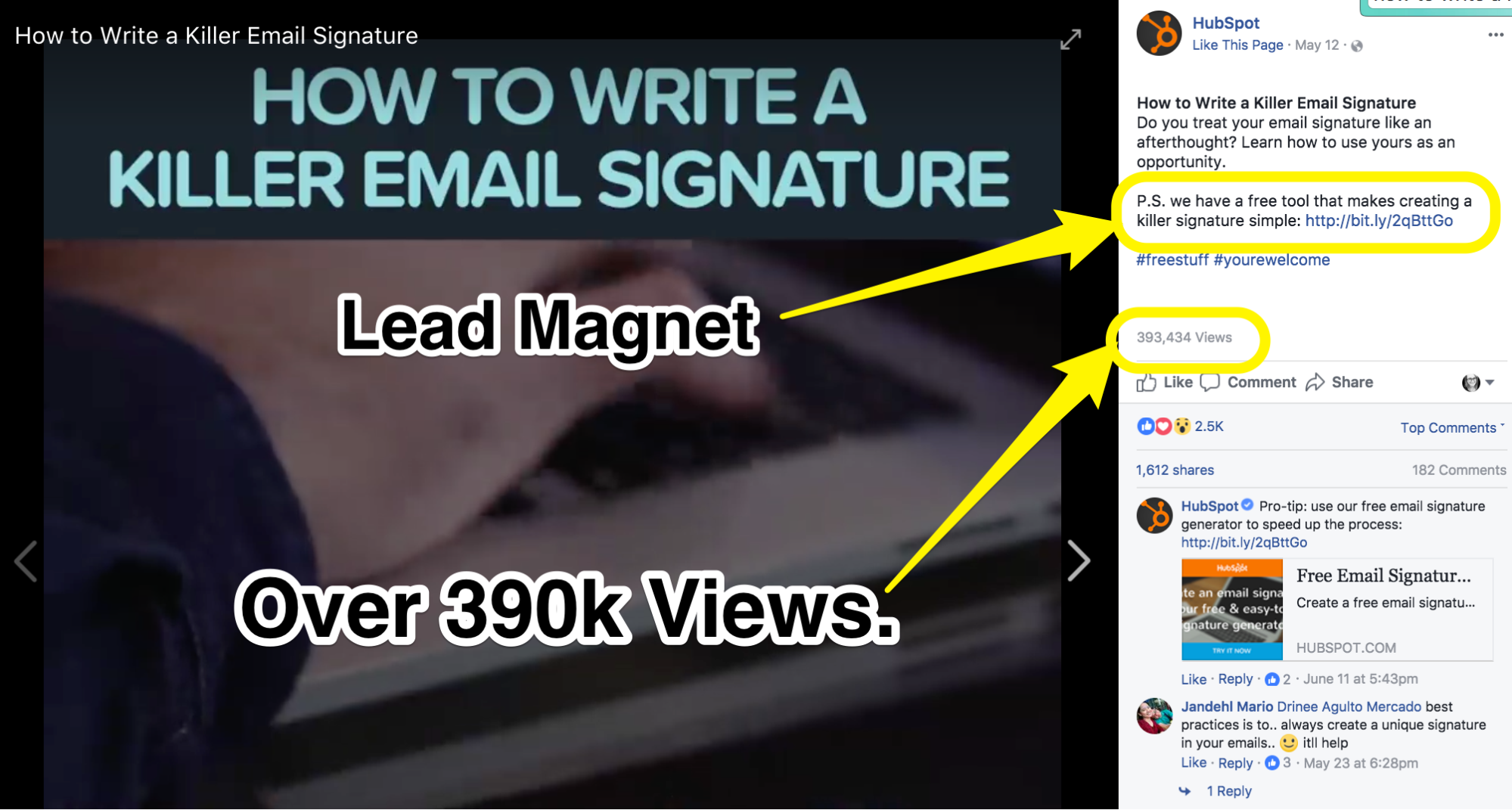
They have a massive amount of Facebook videos all with thousands of views:
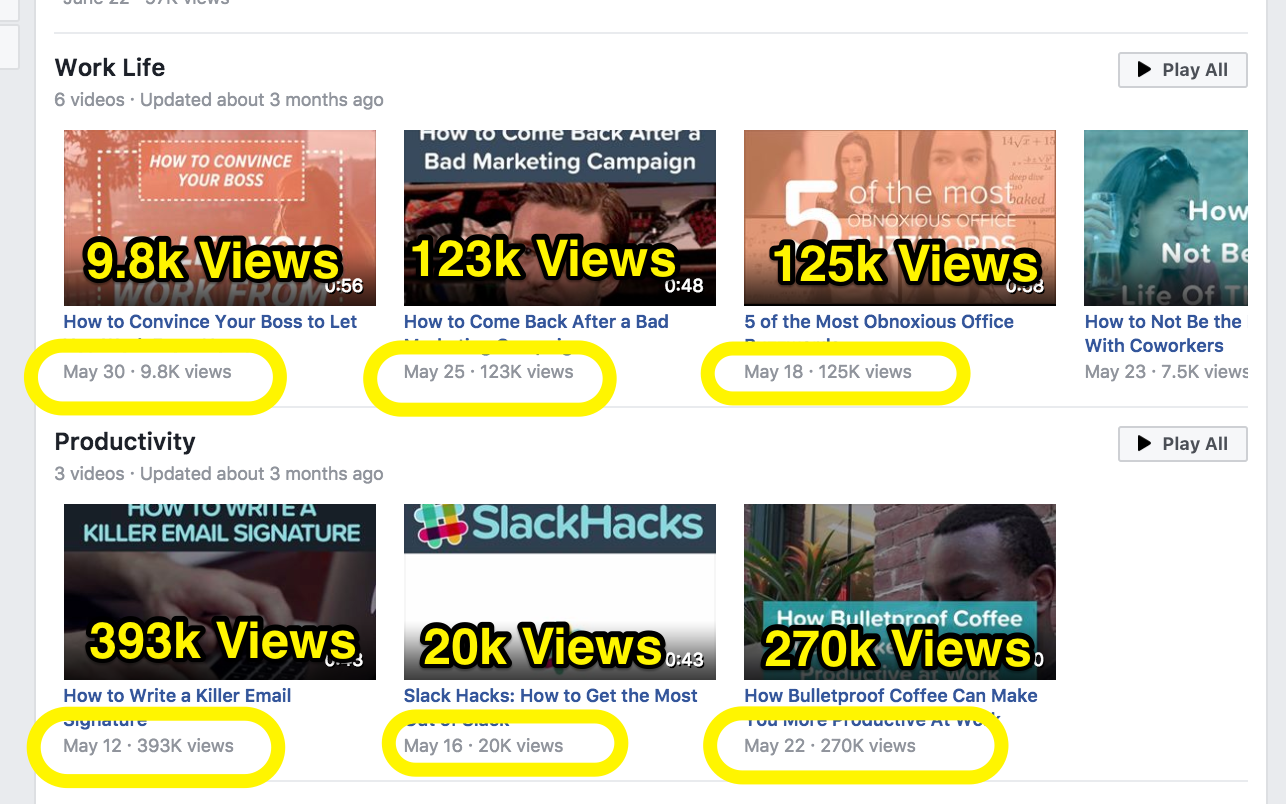
HubSpot has replicated this formula on their YouTube channel. They have over 1K videos posted, 35K+ subscribers and the videos contain links to free products and act as lead magnets (just like their Facebook videos):

HubSpot’s second largest social network is LinkedIn where they have over 191,000 followers.
When I analyzed all of HubSpot’s 400+ LinkedIn posts, I found that there is one type of post that is the most successful and consistently generates over 100 Likes almost everytime without fail.
It follows the same 3-step format every time: short 1-2 sentence description, feature image and link to one of HubSpot’s Facebook videos.
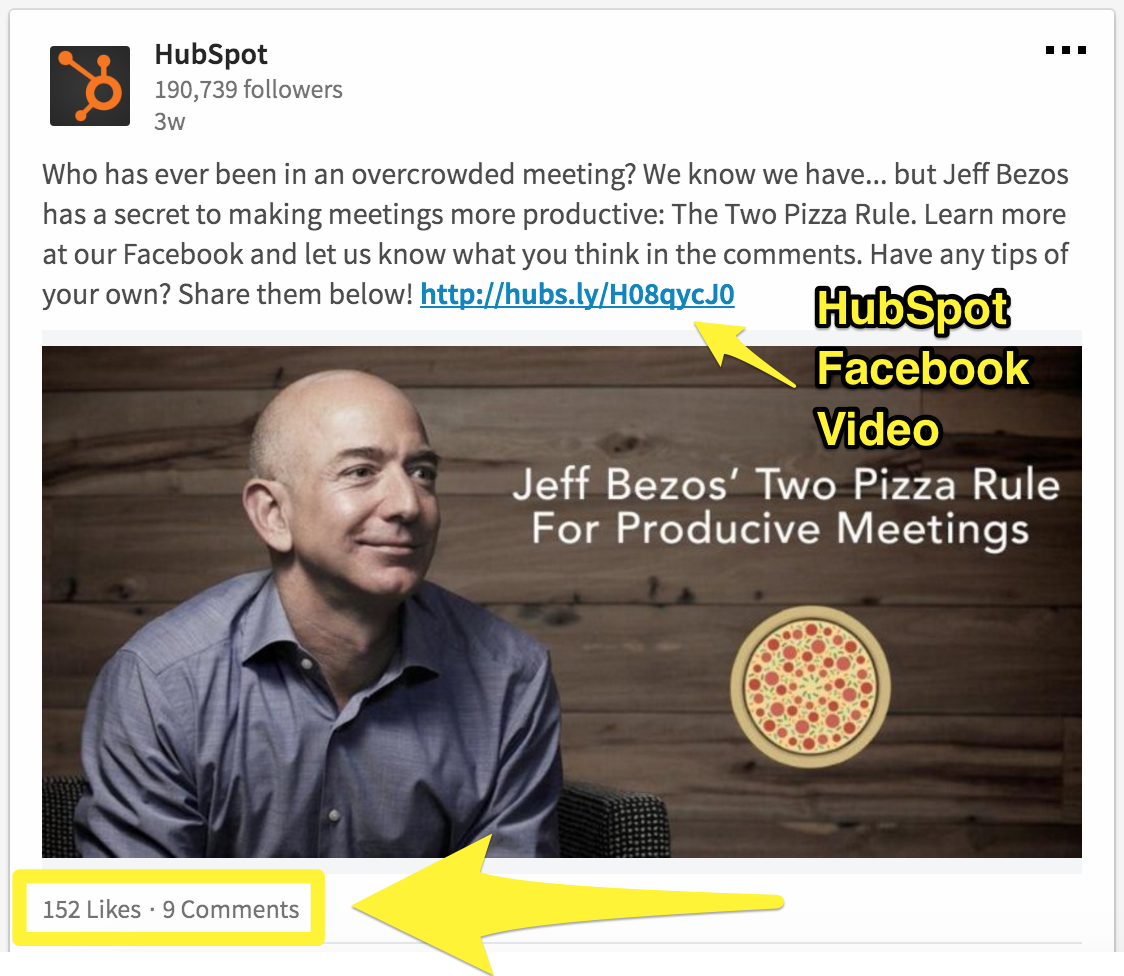
Golden Nugget: Drive text content on LinkedIn to video content on Facebook to growth hack Facebook’s edgerank algorithm so you can get more of your Facebook followers to see your Facebook posts.
HubSpot has close to 1.5M Facebook followers. To make sure more of their Facebook followers see their content without putting $ into the Facebook cash register, HubSpot strategically use LinkedIn to drive traffic to their Facebook posts.
Here is what happens when you click on that “hubs.ly” link:

Here are 2 more examples, so you know this isn’t just HubSpot getting lucky, it’s strategic.
HubSpot’s “work-life balance” LinkedIn/Facebook combination:
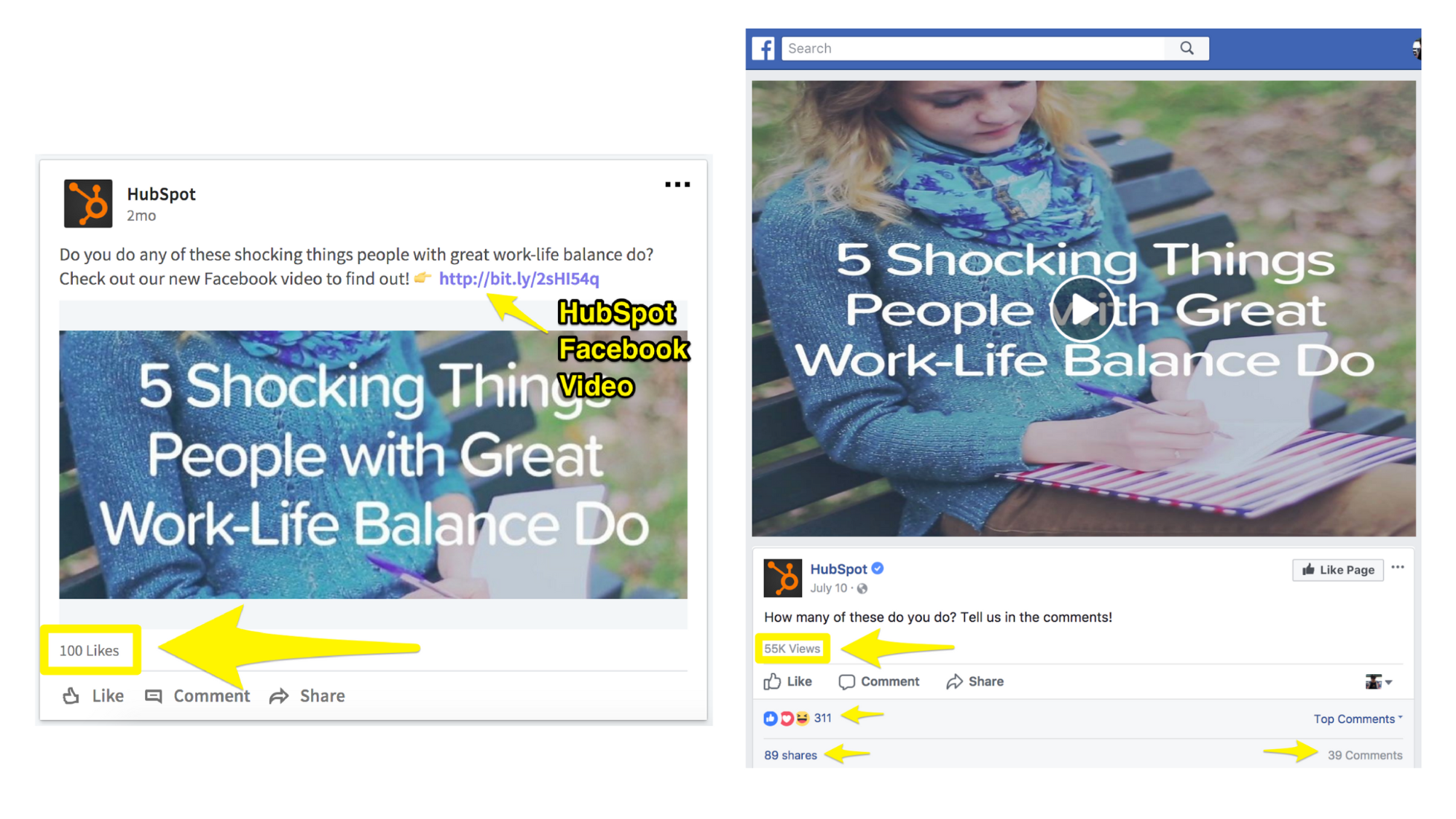
HubSpot’s “Instagram quote templates” LinkedIn/Facebook combination:

To generate leads directly from LinkedIn, HubSpot uses LinkedIn Sponsored Content. Here are the results HubSpot are getting by promoting their offers on LinkedIn:[*]

Here is what HubSpot’s CMO Kipp Bodnar said about it:

Here are 2 examples of HubSpot’s LinkedIn lead generation ads:
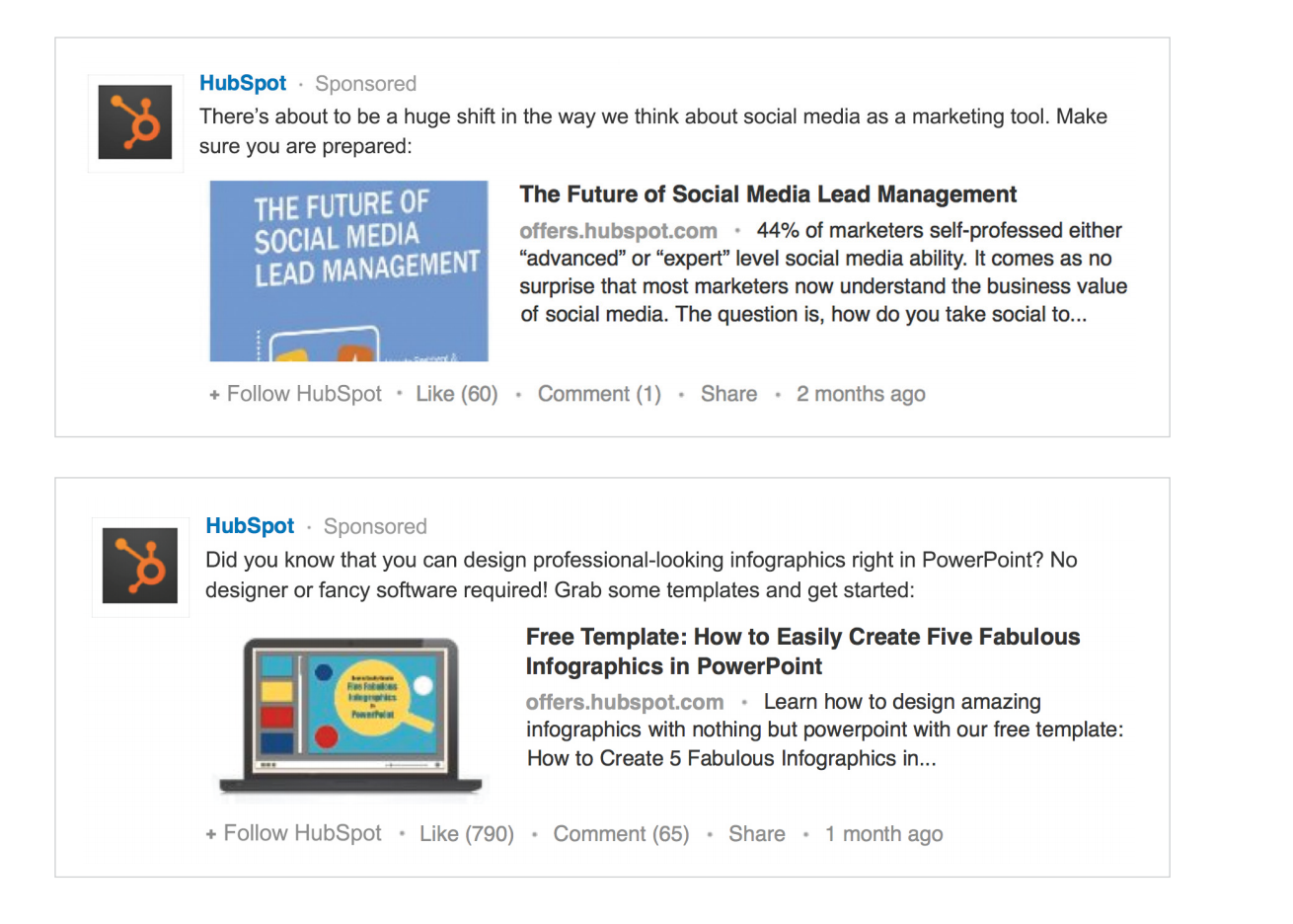
Golden Nugget: Take a look at which of your social media channels has the most followers and engagement, then find a way to growth hack organic engagement on that channel. Use ads to promote your content that prospects would highly value, then funnel them into becoming a lead. (HubSpot do it by posting links to their Facebook posts on LinkedIn, so they can get more people to see their content on LinkedIn and Facebook. They then use ads to promote content offers and collect leads).
[Tip #3] How To Make Your Website Visitors Stay On Your Website For Over 6 Minutes With “Content Stacking”
HubSpot dot com is HubSpot’s public facing main site. It gets an enormous amount of organic (earned) traffic from the search engines. HubSpot put A LOT of focus on content marketing and SEO.

They have thousands of generic key phrases like “Website Leads” and “Grow Email List” ranking on the first page of Google.
From analyzing HubSpot’s 69,087 organic keywords I could count 5,905 that rank on the first page of Google and 10,440 that rank on the first page of Bing/Yahoo!.

There is a lot of valuable content accessible from the HubSpot website which I believe is contributing to their low bounce rate and high time on site.
On HubSpot’s blog articles they offer hundreds of different lead gen incentives (to match their blog article content) in exchange for a full lead.
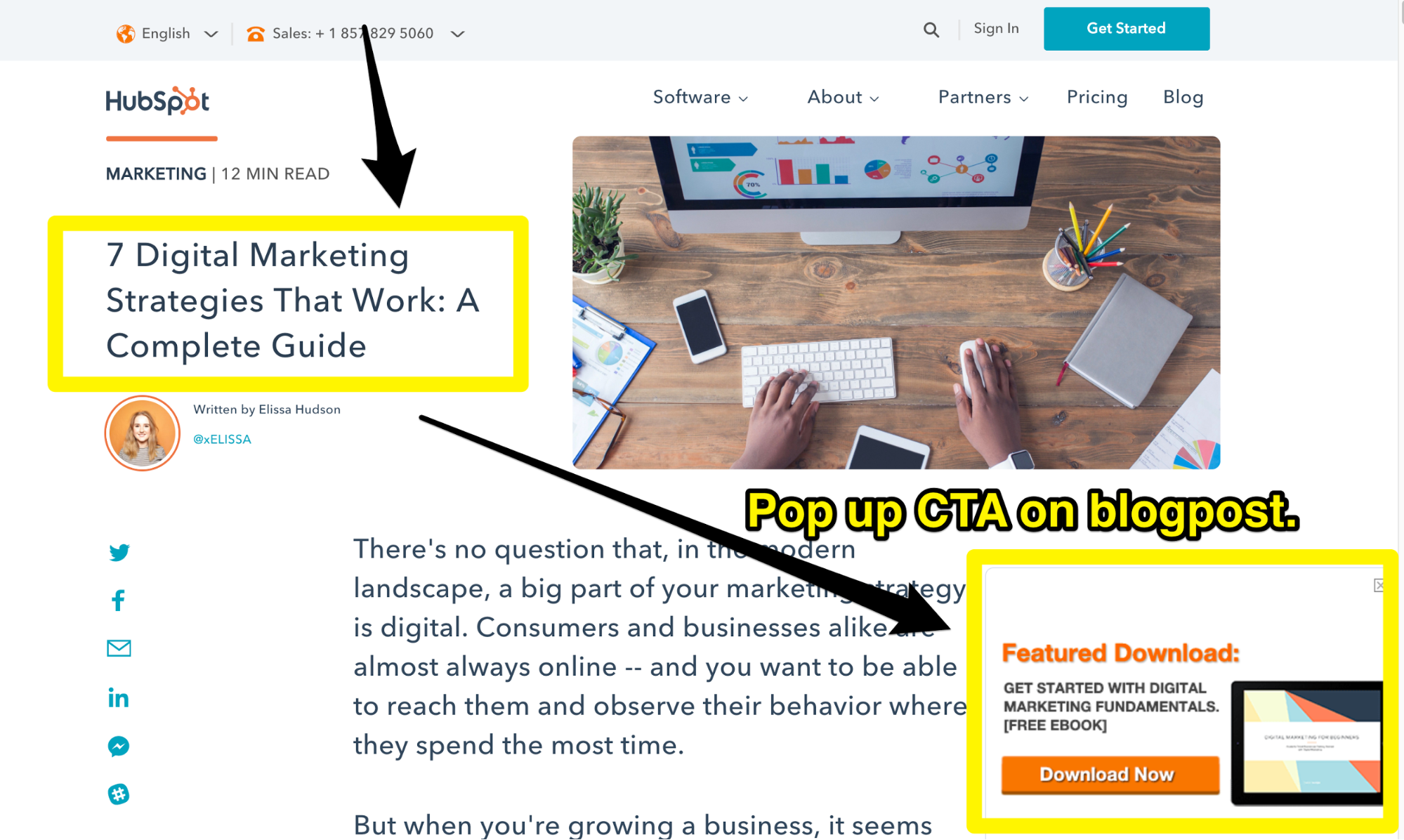
Click here to reveal the scroll box tool you can use to do this.
Their blog post CTAs and ads are driven to landing pages with a very basic level visual design, short form copy and a full lead form:


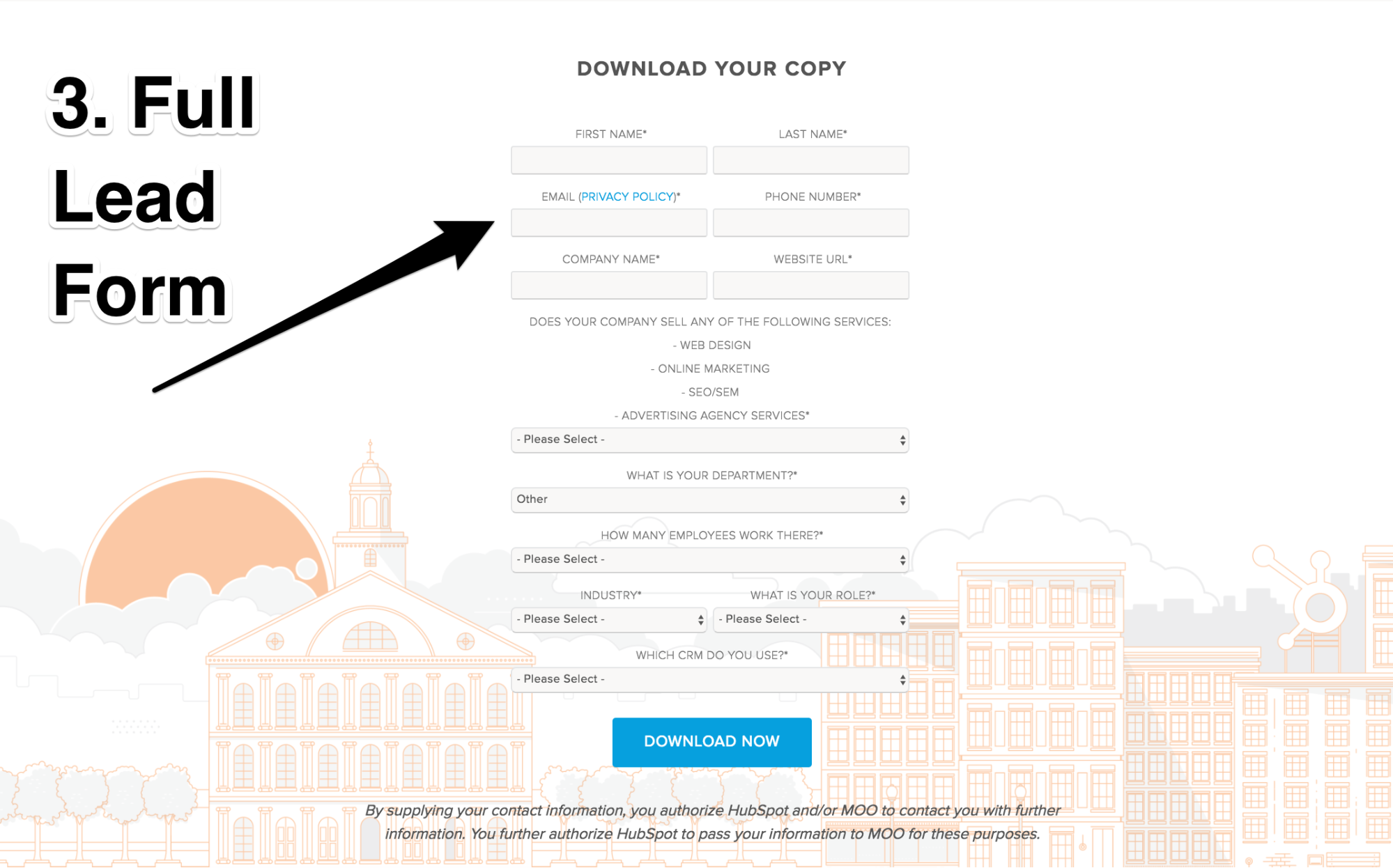
Once you opt-in you are taken immediately to access the free guide and HubSpot then gently nudges you to sign up for their free CRM software:

HubSpot then brilliantly uses their free downloadable guides as lead generators to further qualify leads by adding very relevant links to more resources that take readers to various ‘next steps’ based on where they are in the funnel (download another resource, book appointment, etc).
This builds up HubSpot as the industry expert, which builds trust with the user so they are more likely to convert into a paid customer.
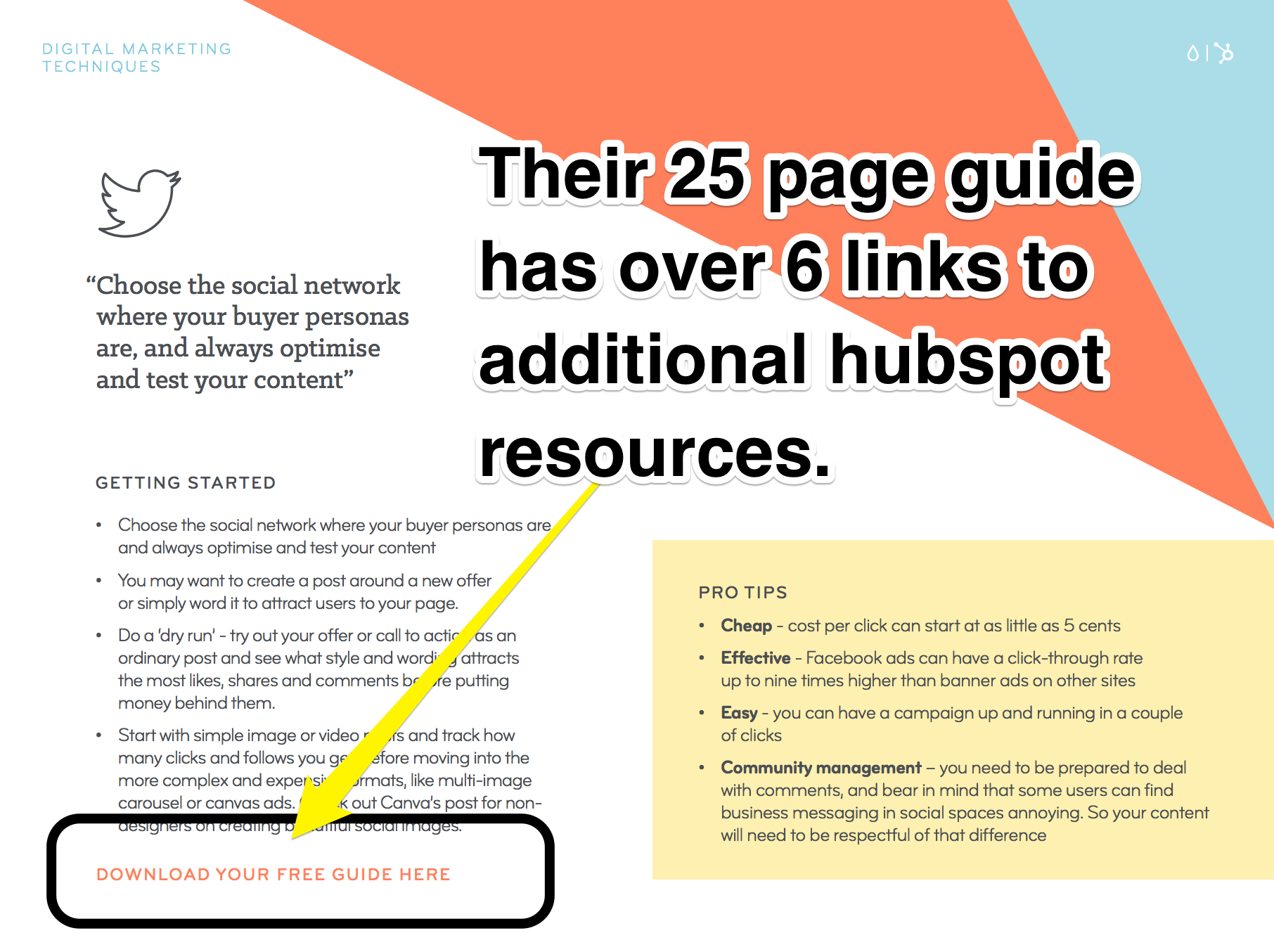
Beyond the lead HubSpot sell inbound marketing software for a subscription fee based on their customers number of CRM contacts.
The takeaway: Use “content stacking” to get people reading your content for over 6 minutes so they are more likely to convert. HubSpot do it with this three content stack:
Content Stack #1: blog content
Content Stack #2: downloadable pdf guide content
Content Stack #3: resource-based content (courses, webinars, templates, etc)
[Tip #4] HubSpot’s Content Upgrade Conversion Machine: Create 1 Content Upgrade For Every Blog Post You Write
Notice that some of HubSpot’s blog posts aren’t the type you’d typically see on a website that sells inbound marketing software.

Their most shared post generate leads for their HR department to fill their product management jobs pipeline (high-growth companies need to hire!):
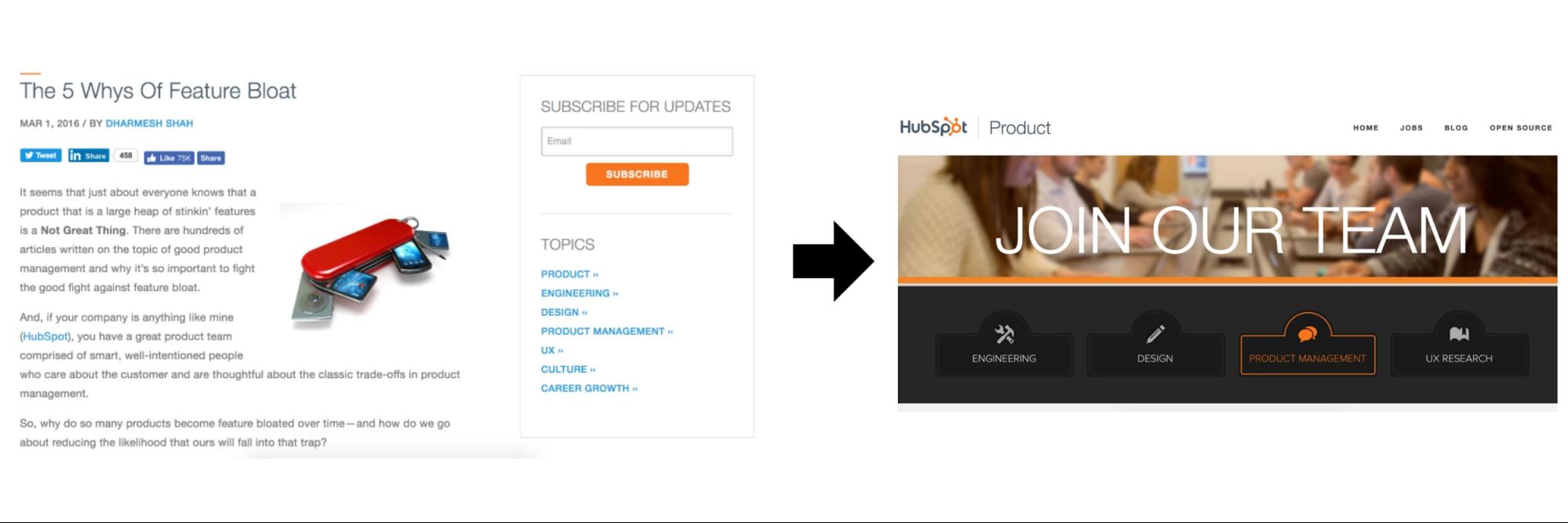
The second most shared post is an opt-in page for a free guide on “How To Use Excel”:
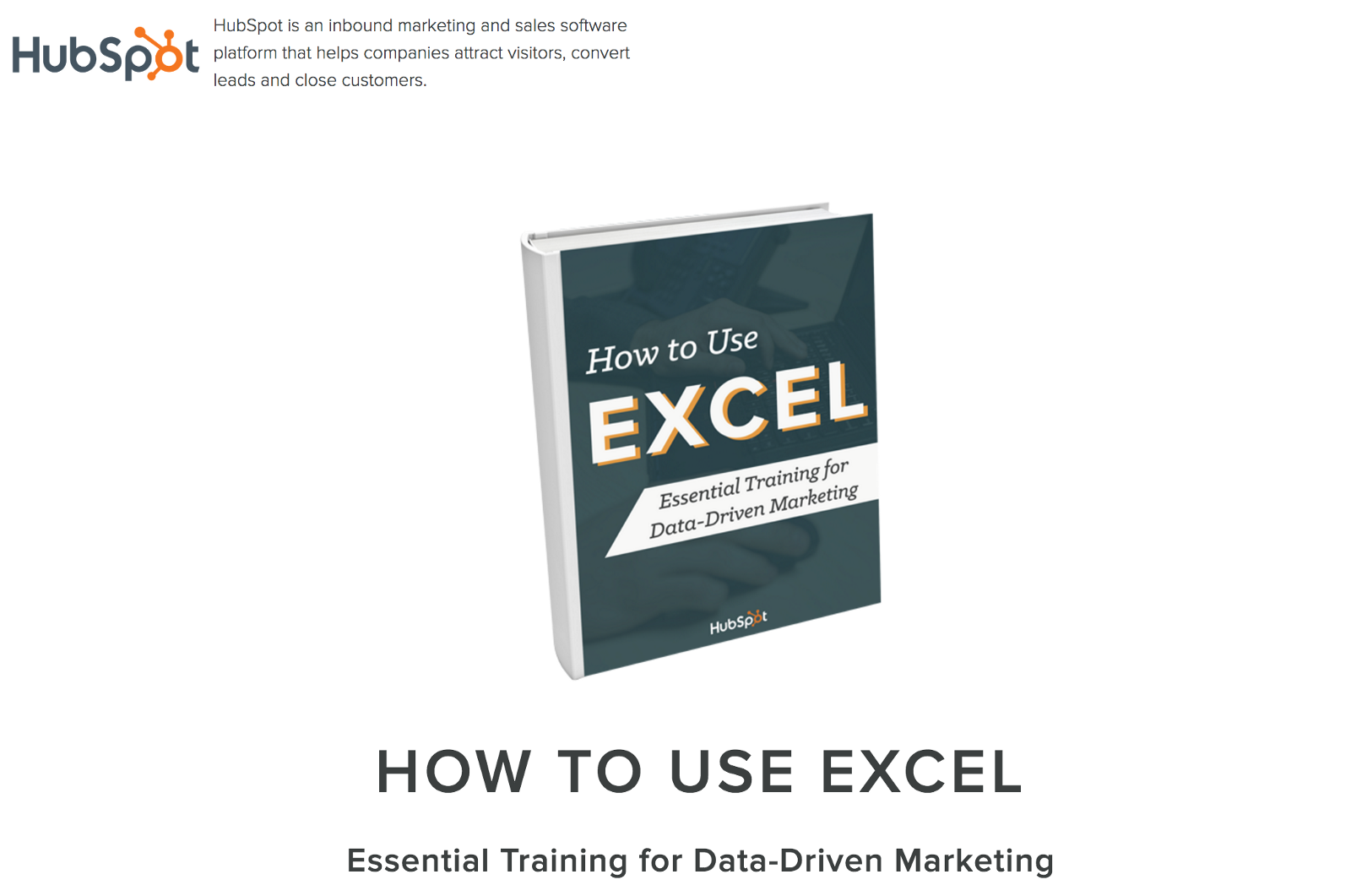
You may be thinking… why in the heck are HubSpot teaching people how to use excel?
Trust me… this isn’t a mistake.
The smart team over at HubSpot did their research and found that there are 27,000+ people every month searching for “how to use excel”.

When you search for “how to use excel” on Google, the first organic search result to pop up is a HubSpot blog post titled “How to Use Excel: 14 Simple Excel Shortcuts, Tips & Tricks”.
And guess how they are using that blog post to generate leads?
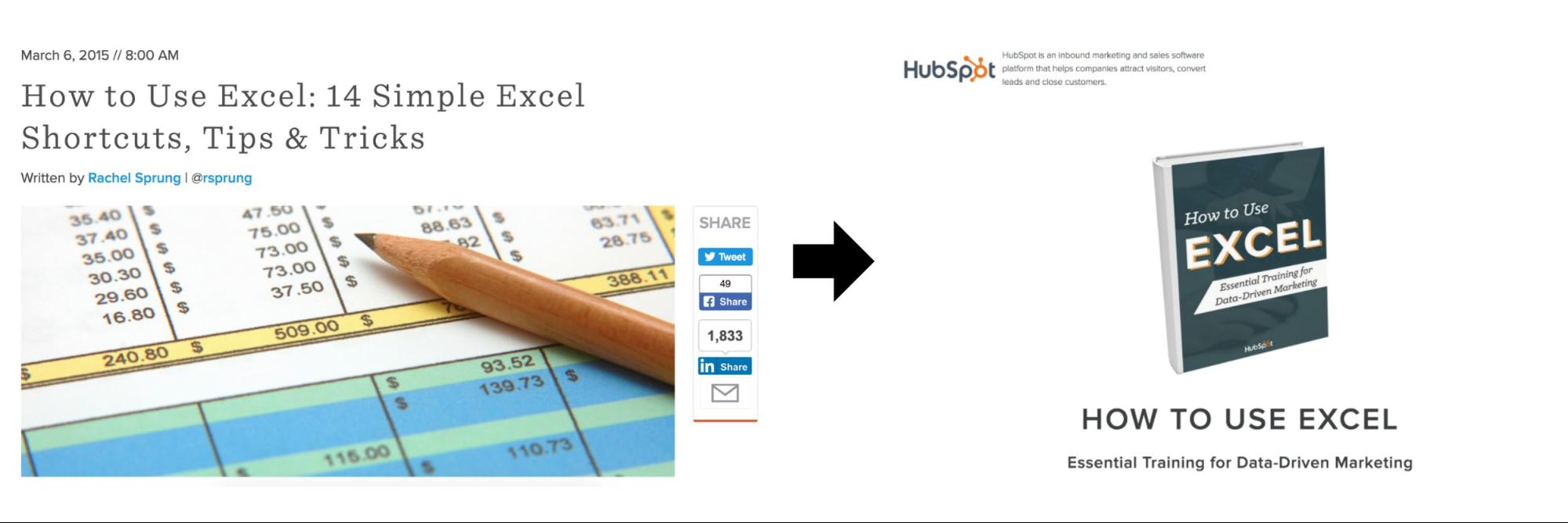
In the blog post they have 3 calls-to-action that link to their “How To Use Excel” guide:
- Native Link CTA at the start of the blog post
- Scroll Box CTA on the bottom right after you scroll 20% down the page
- Image CTA at the bottom of the blog post

Click here to reveal the content upgrade tool you can use to do this.
If you take a look through HubSpot’s blog, you will see that these 3 blog post CTA’s for content upgrades are consistent across most of HubSpot’s blog posts.
Sometimes they all go to the same content upgrade (like in the example above). Other times, all 3 CTA’s will go to 3 different landing pages with 3 different content upgrades relevant to that blog post.
HubSpot has thousands of these “owned media” content upgrades, with their own dedicated landing pages.
Here is an example of 5 blog posts and content upgrades from HubSpot’s Marketing Blog that they are using to fill the top of their funnel:
| Blog Post | Content Upgrade |
| How to Plan a Content Marketing Strategy: A Start-to-Finish Guide[*] | Marketing Plan Generator[*] |
| 6 of the Best Messaging Apps for Different Scenarios[*] | The Marketer’s Guide To Mobile[*] |
| 5 Overlooked Metrics Your Agency Needs to Measure for a Profitable 2017[*] | New Client Intake Form[*] |
| How to Build a Process for Growth Experiments[*] | 2017 Marketing Experiment Templates[*] |
| 8 Timeless Business Lessons From Bill Belichick[*] | How To Be A Leader eBook[*] |
As you can see… HubSpot are an inbound content AND lead generating machine!
One thing HubSpot do really well, is update old blog posts to make them relevant again today with an Editor’s Note at the top of post to let people know what has been updated.
Here is an example:
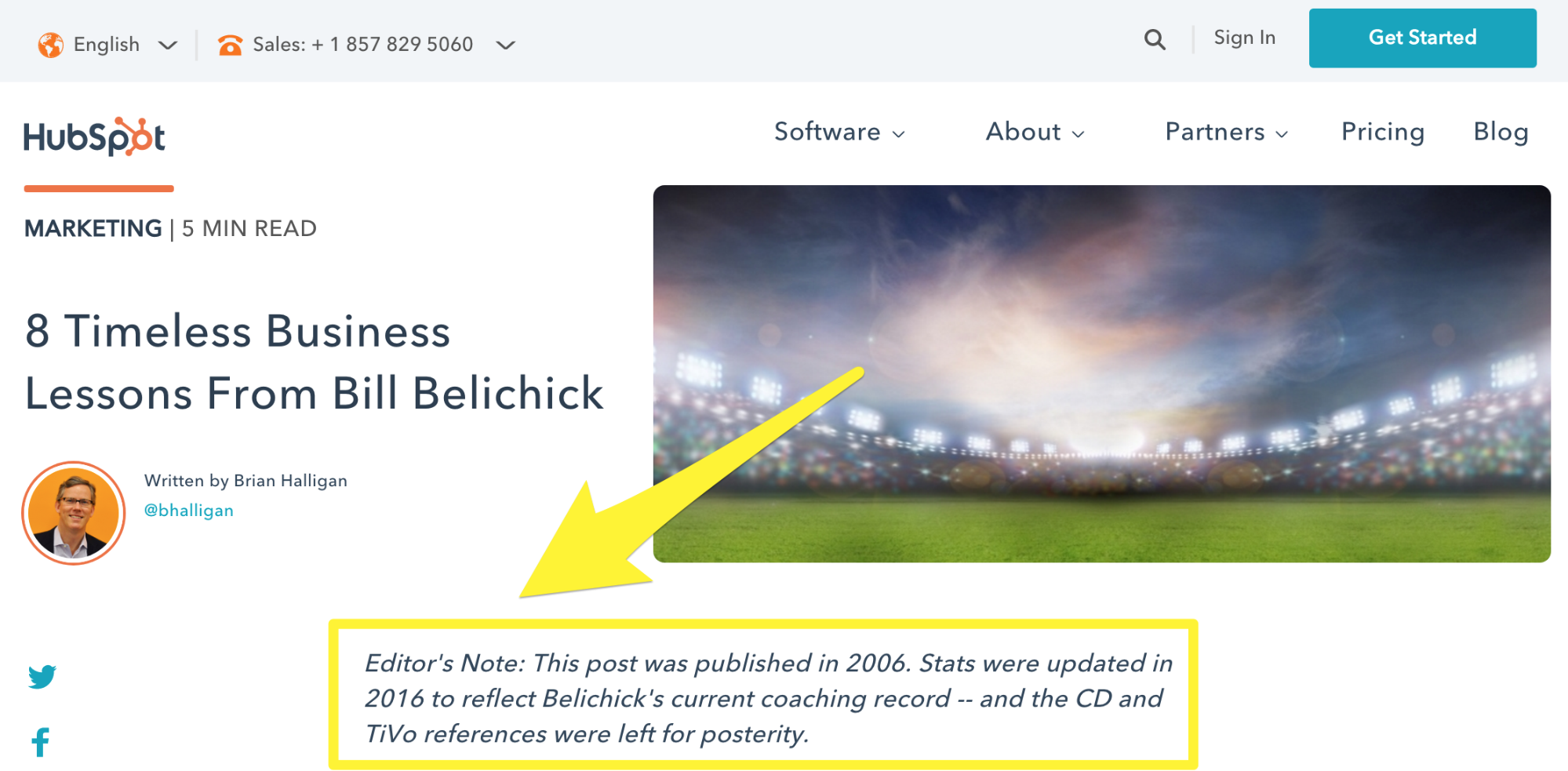
This is a great strategy to generate more leads from old, evergreen content pieces.
Once someone opts-in for a content upgrade, HubSpot then use their own product to do their email marketing.
To see how insane the open rates are using HubSpot I tracked down one of HubSpot’s biggest power users and bribed him with tacos to give me his HubSpot email data.
Here are the open rates my buddy Justin Brooke over at AdSkills is getting using HubSpot to send emails:[*]
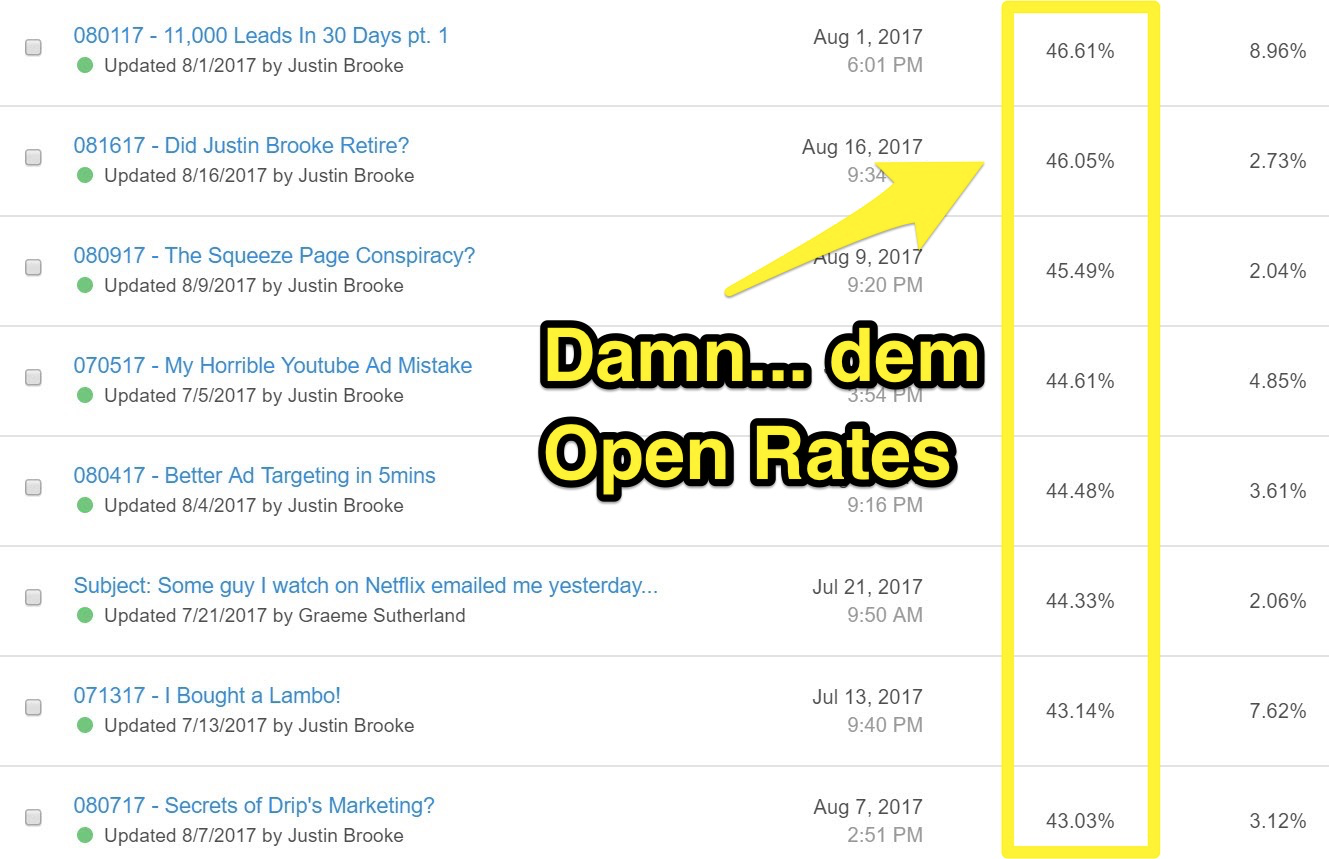
Go check your email open rates now and compare.
If you aren’t getting high open rates like that, then you may want to test out HubSpot. They are the king of making sure you have a clean email list and keeping deliverability to your customers inbox at an all-time high.
The takeaway: Research blog post ideas to create your own content calendar, create one content upgrade for every one blog post you write and use an email marketing tool that automatically cleans your email list and has high deliverability (HubSpot does it by researching high volume marketing topic keywords, writing an in-depth article on the topic and using 3 CTAs that link to a content upgrade to capture leads with every piece of content. They then use their own tool to email leads).
[Tip #5] Get Silicon Valley Serial-Entrepreneurs To Guest Write On Your Blog By Stroking Their Ego
ThinkGrowth.org is a HubSpot Medium Publication that was launched on April 17, 2015. It was first branded as ReadThink.com, then re-branded to ThinkGrowth.org on Dec 14, 2016.
This one Medium Publication alone generates HubSpot 333,000 website visitors per month.

Here is what Janessa Lantz, Principal Content Marketing Strategist at HubSpot said about what their Medium publication represents:
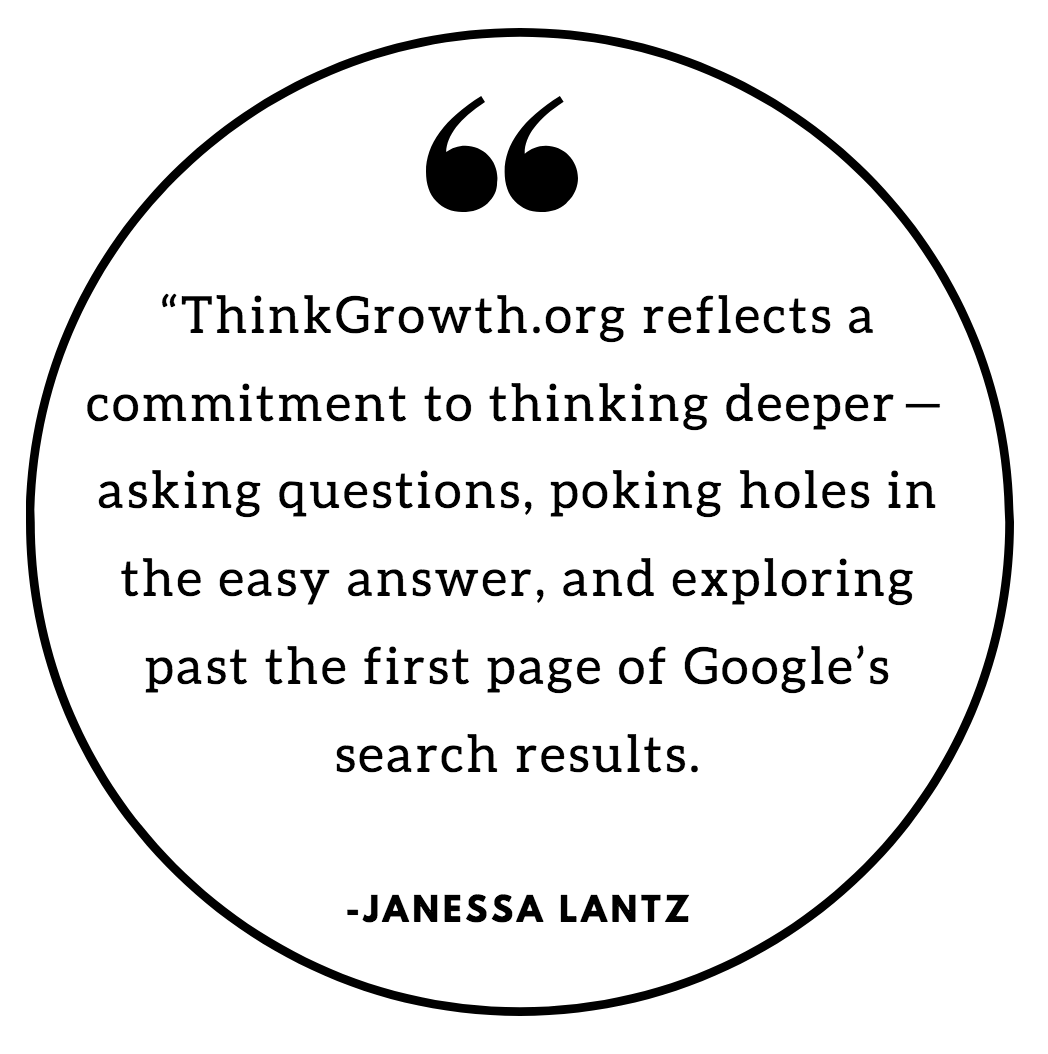
ThinkGrowth.org provides engaging and relevant content that connects the readers. Here’s a few responses to their articles:
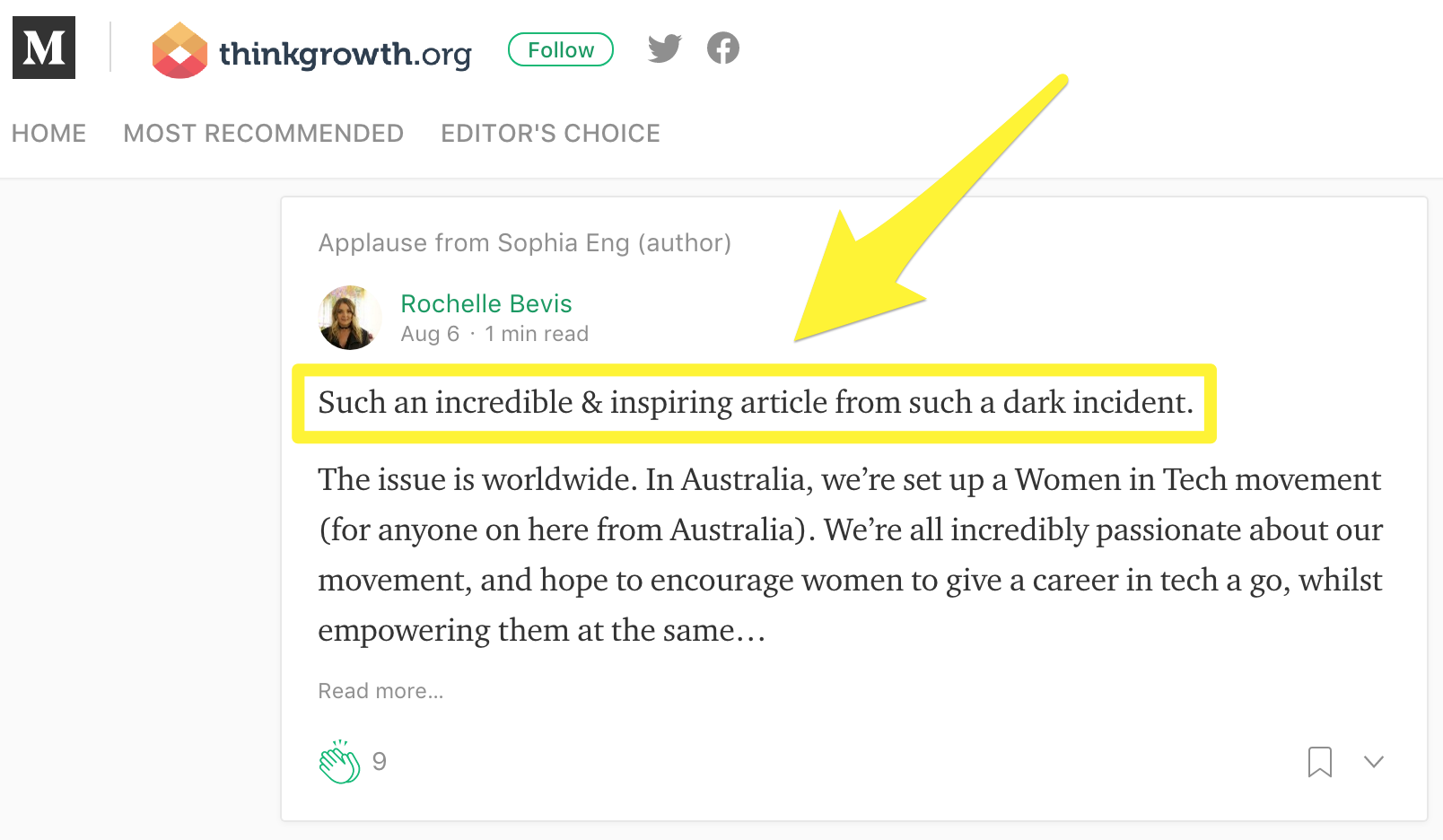
HubSpot’s launch on Medium was based on this premise: more and more people are consuming articles directly from platforms like Medium, Facebook, and podcasts so they want to be where their readers are.
Early posts were mostly cross-published content from the HubSpot blog, but HubSpot quickly realised that their “optimized for search” blog content wasn’t generating many views on Medium.
They had the best success by finding writers on the rise on Medium like Seth Godin, Nir Eyal, Larry Kim, Steve Blank and Danielle Morrill and syndicating content they had created — exposing both them and HubSpot to a new audience.
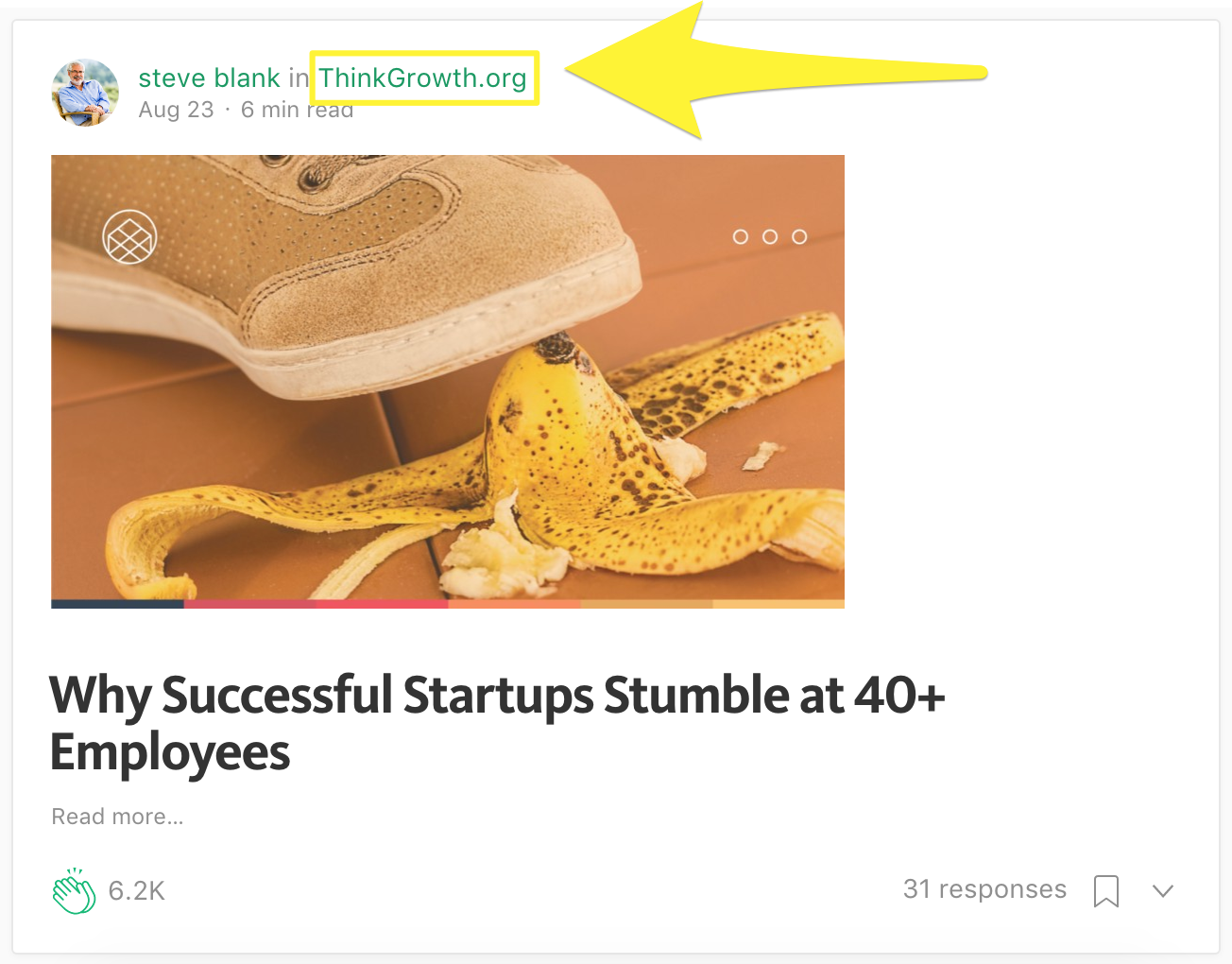
By “optimizing for people” with opinion pieces, personal accounts and reaction posts from top writers and influencers, HubSpot found content that would often have a stronger performance than their home blog.
HubSpot got influential people to write on their blog in one of two ways:
- Referral from someone within the company
- Previous relationship from The Growth Show podcast (Steve Blank’s podcast aired on June 20, then his Medium post went live 2 months later on August 28)
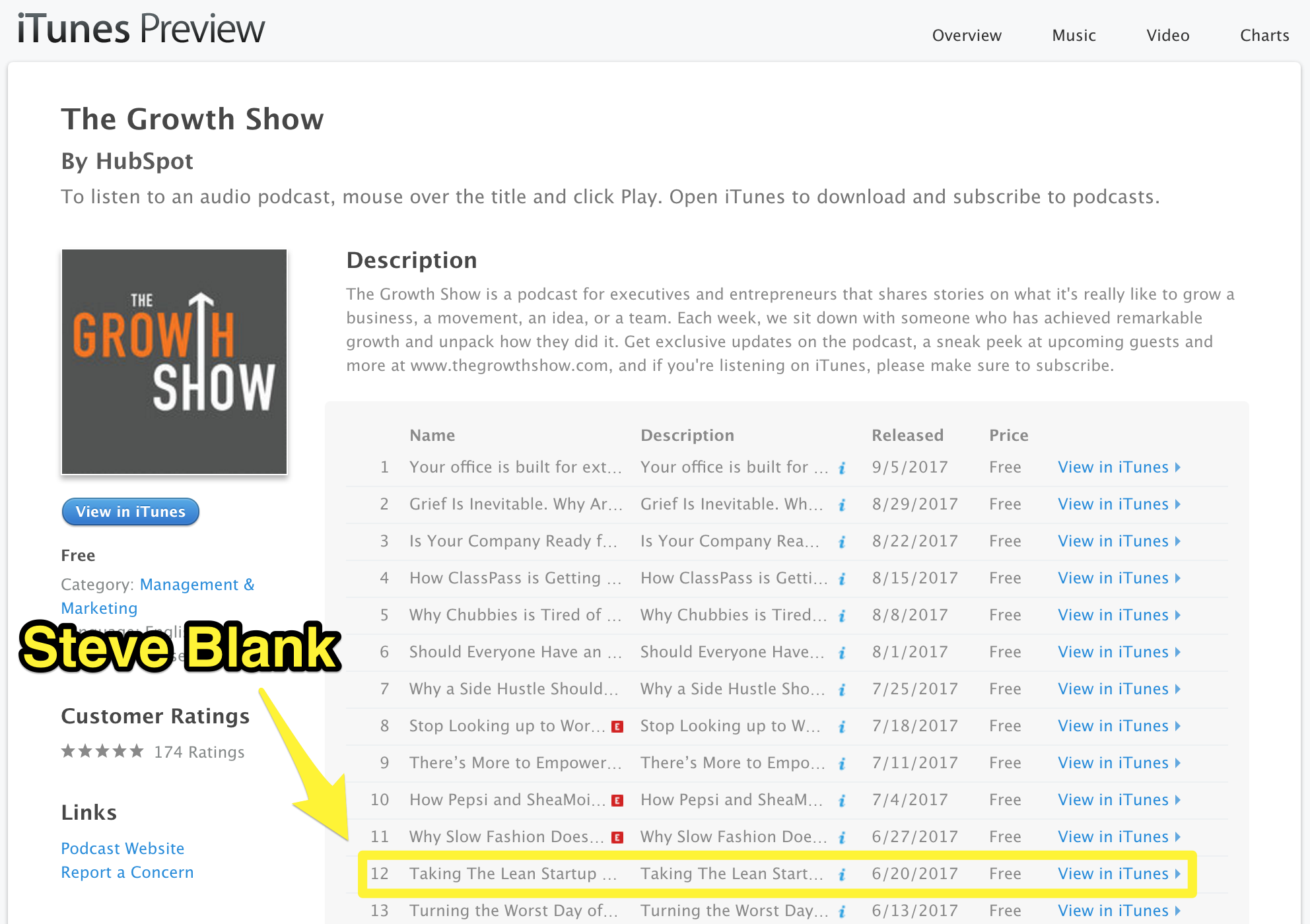
Golden Nugget: Do an interview-style podcast or video, then pick out the the #1 point that resonated with your audience and ask your interviewer if they would like to write a guest post on the topic.
Here is HubSpot’s traffic performance during their first year on Medium when they executed this strategy:[*]
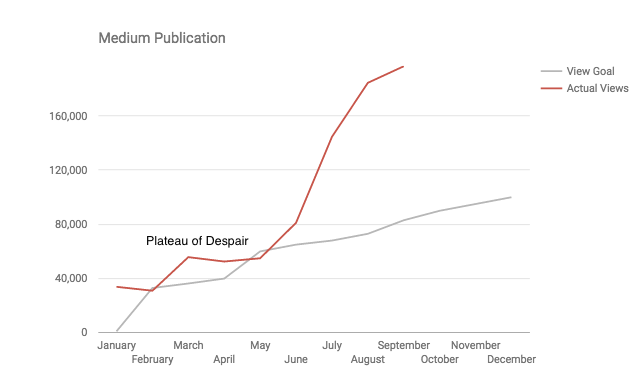
Not only did HubSpot breakthrough the “Plateau of Despair” and grow well beyond 160,000 views per month, but their Medium publication is now the 19th largest publication on Medium:[*]
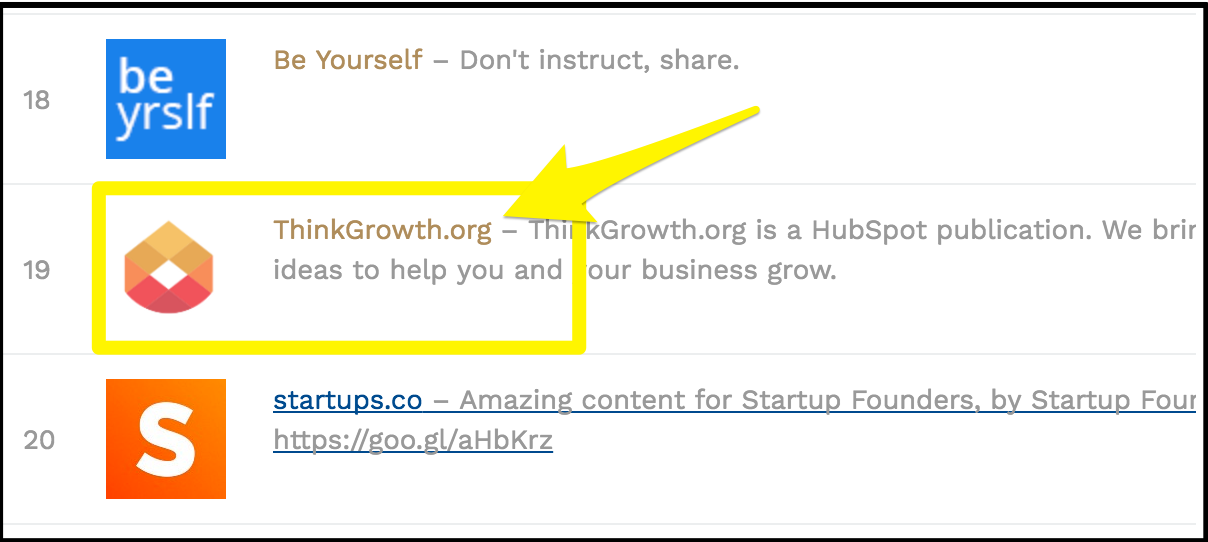
Since their success on Medium, HubSpot has decided to invest in a brand new team focused entirely on “offsite” content strategy.
They have over 150 guest writers and take guest submissions at medium@hubspot.com
The takeaway: Get influencers to guest write on your blog by incentivizing them to do it (HubSpot do it by incentivizing guest writers with access to HubSpot’s audience).
[Tip #6] Community Marketing: How To Build A 170,000 Member Community That Generates $100M Revenue Per Year
Inbound.org is an online hub for marketers to connect, learn and find jobs. It is funded by HubSpot Labs, an R&D department within HubSpot.
This website alone generates over 300,000 website visitors per month for HubSpot.

HubSpot gets this volume of traffic to their community site in 3 ways:
- 170,000+ community members who go direct to the site to login
- Organic search traffic
- Social traffic (80%+ from Facebook and Twitter)
HubSpot’s top organic keyword for Inbound out of 1,605 keywords is “remote working jobs.” It drives over 3,000 website visitors to Inbound every month.

Here is what the landing page for that keyword looks like:
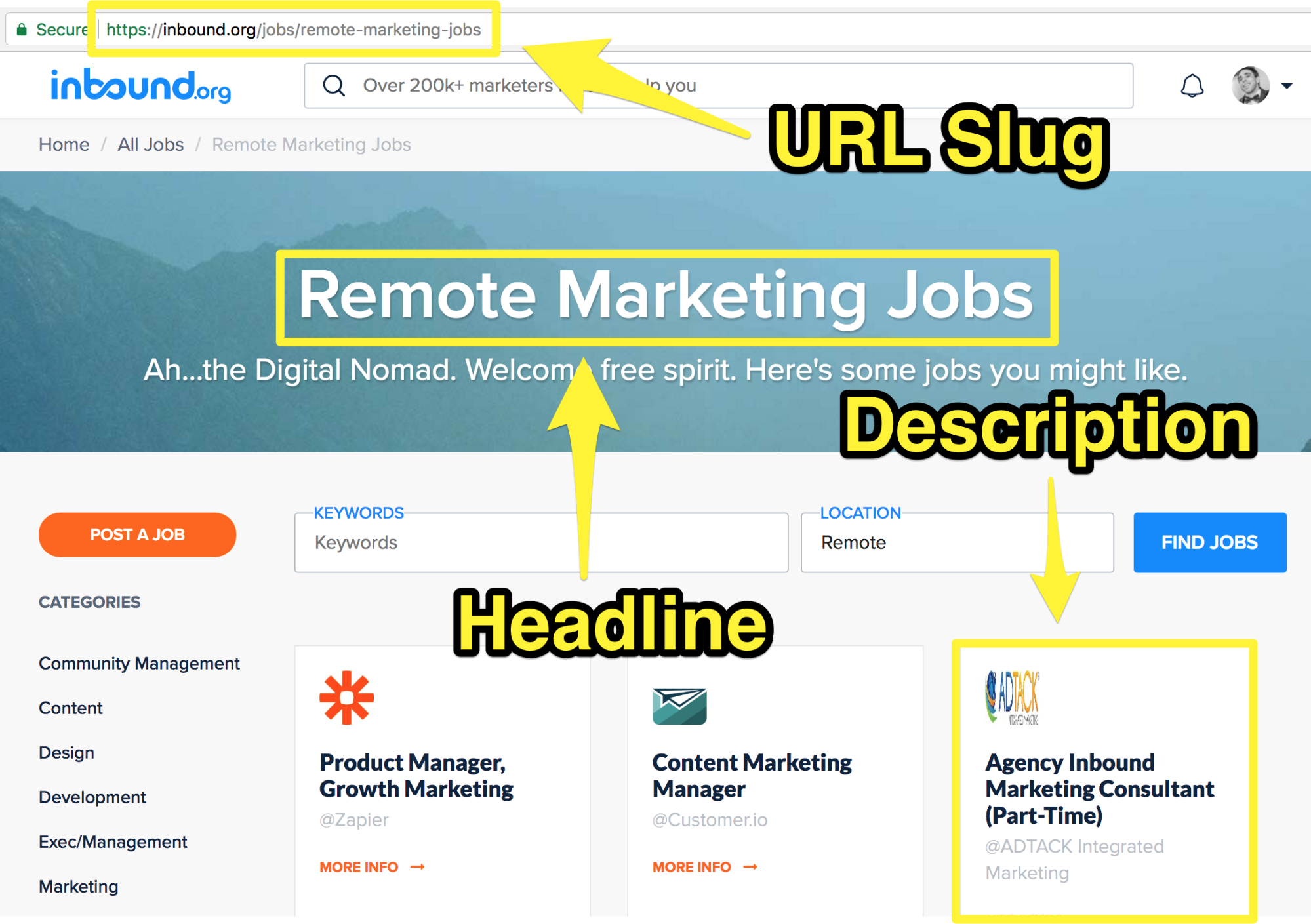
This is a perfect example of how to structure your blog category pages for organic SEO traffic success:
- Keyword in the URL slug
- Keyword in the headline
- Short descriptions of articles/jobs/etc
To grow social traffic on Inbound, HubSpot do 2 things very well.
- Promote Inbound Original posts from experts in the community to the top of the Inbound homepage and on Facebook
- Use a sticky Share bar at the bottom of posts
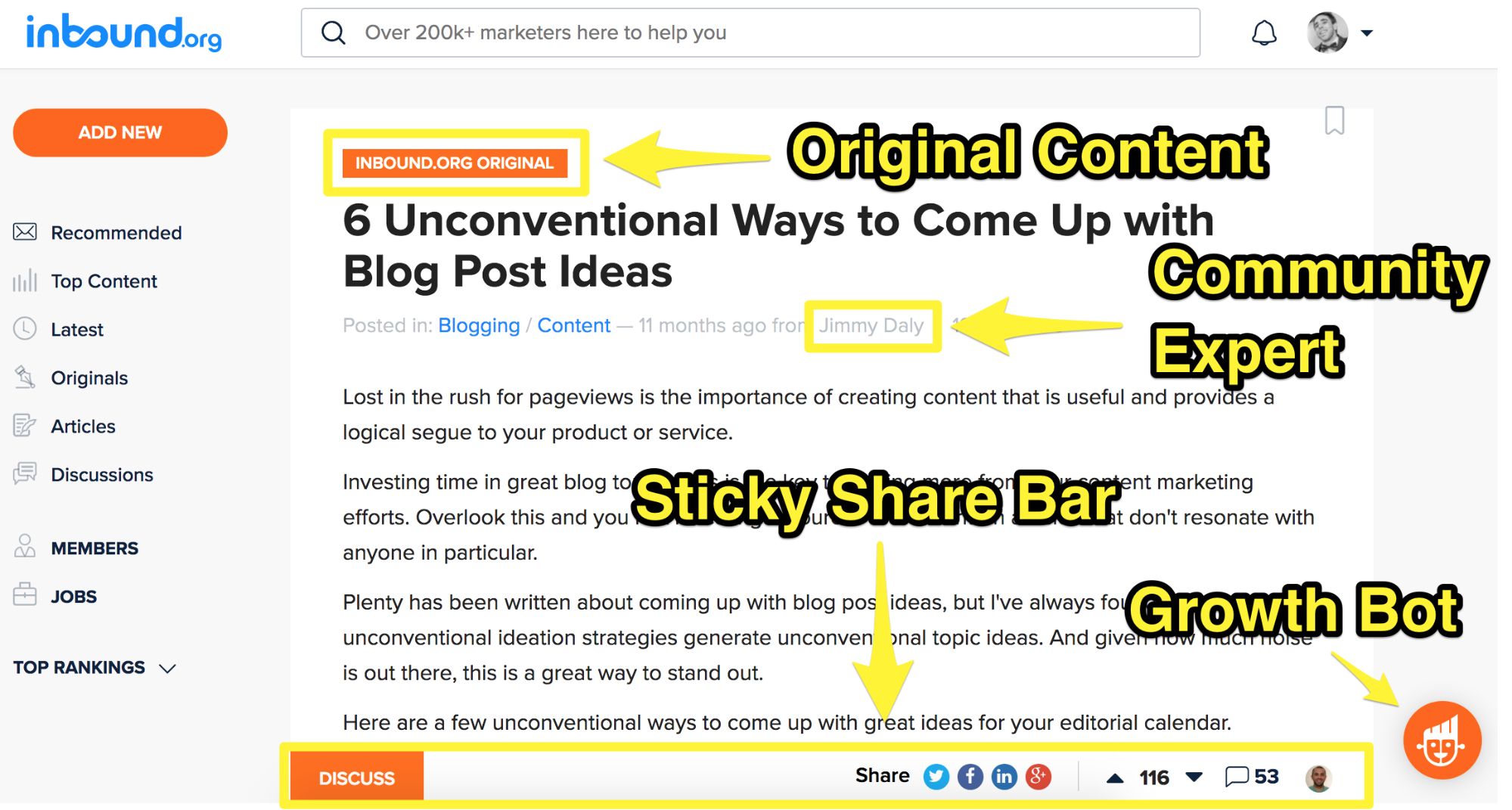
Click here to reveal the share bar tool you can use to do this.
The Inbound Original articles are consistently the Top Content on Inbound every month. By getting experts to share their “insider information” on everything inbound marketing, HubSpot give marketers a real reason to be part of their community.
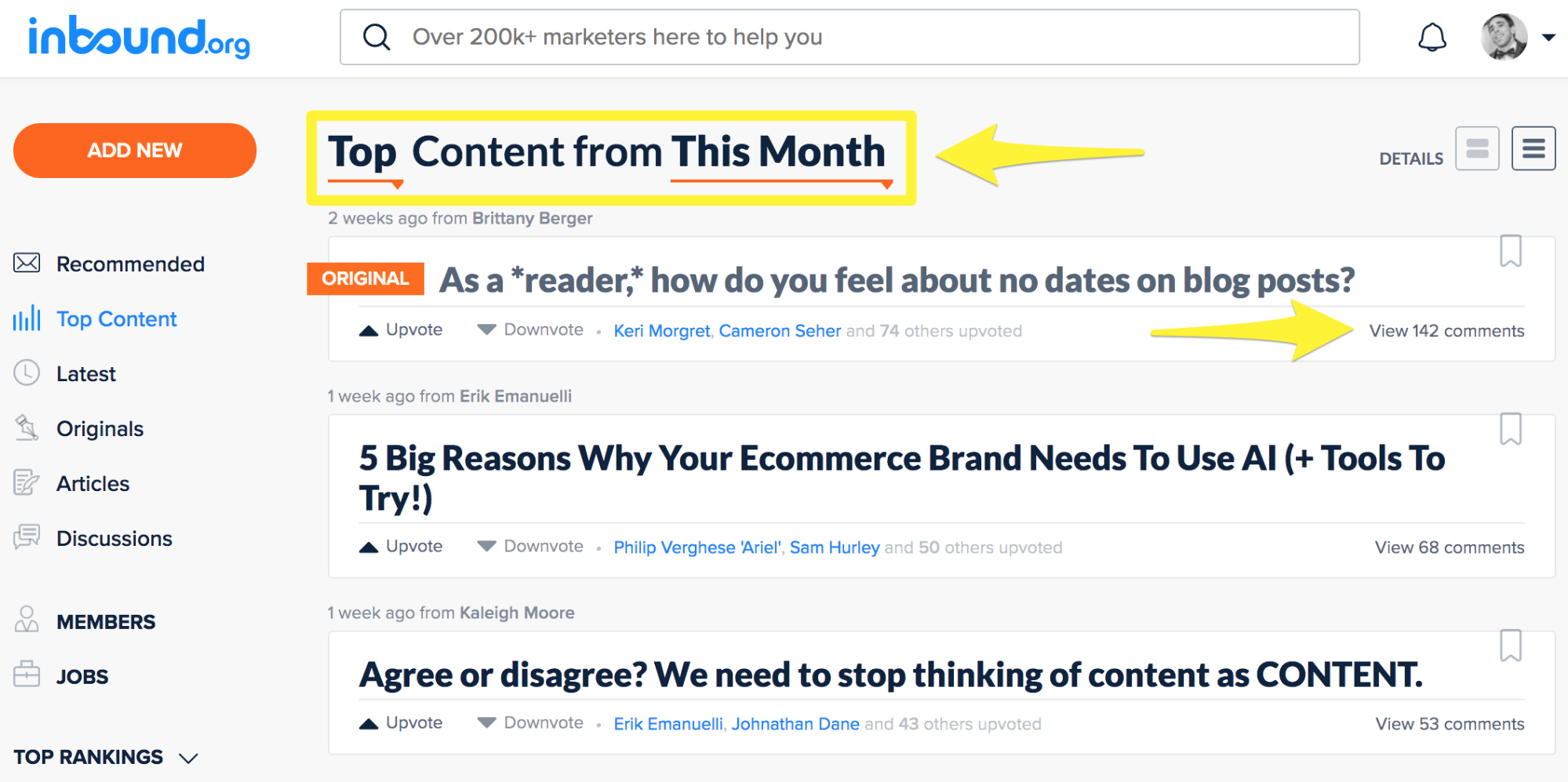
The reason these articles are so successful is because HubSpot’s Inbound team have a high level of quality control over every Inbound Original that gets published to the site.
Here is an example of this quality control in action when I sent Keri Morgret from Inbound this content piece about lessons learned growing Sumo’s blog from 100k/mo to 200k/mo traffic in 1 month:
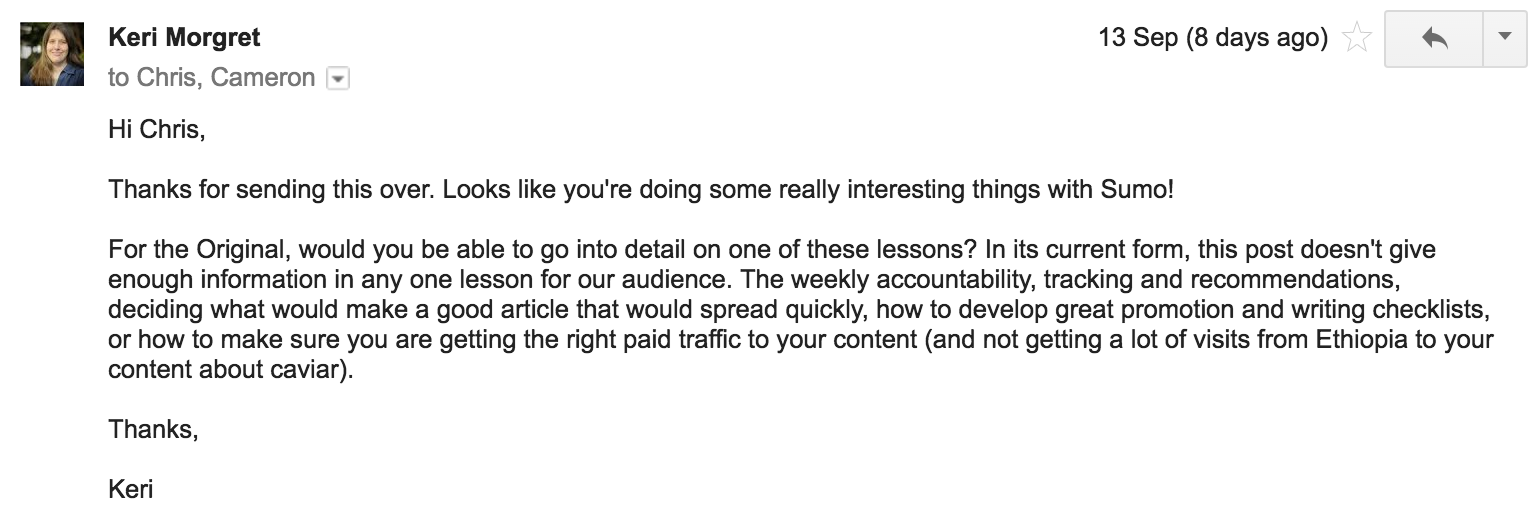
To add fun to the community, HubSpot also have a cool little chatbot called “GrowthBot” on the bottom right corner of every Inbound page where you can ask marketing and sales questions.
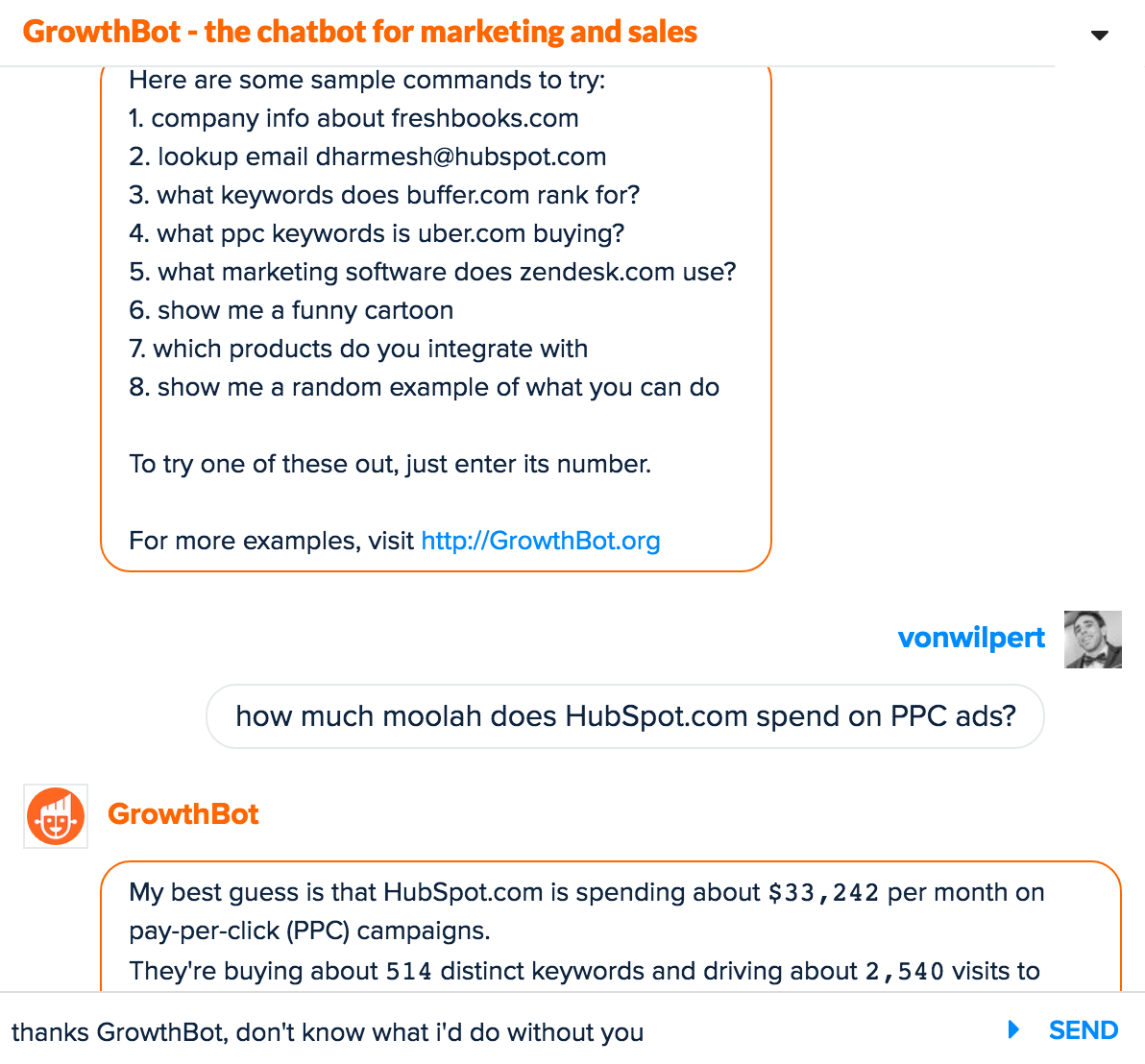
This chatbot is another unique value-add HubSpot added to differentiate their community from other online marketing communities.
Why does HubSpot go to all this effort to build a strong community?
Because one of HubSpot’s largest revenue generators is from marketing agency partners.
Just like Xero leverage accounting partners to grow their business, HubSpot’s marketing agency partners account for 40% of their revenue (as of their last earnings call).
The Inbound community is the perfect spot for HubSpot to help their marketing agency partners stay on top of the latest marketing trends, help them find new hires, and get access to unique content they can’t get anywhere else on the internet.
HubSpot extend the value with their Inbound live event in Boston.

HubSpot’s Inbound community has become so successful that they now have 3,400+ partners servicing thousands of HubSpot customers, helping them get better results, month in and month out.
HubSpot have nurtured their marketing agency partners through Inbound so well that their partner program for marketing agencies recently scaled up past $100M in annual revenue.
The takeaway: Build a successful community around your brand by adding value that people can’t get in other communities. Focus on making the people in your community successful (HubSpot do it with Inbound Originals, a Remote Marketing Job board, GrowthBot and their live Inbound conference).
[Tip #7] 3 Paid Search Funnels That Make HubSpot Rich (Hint: SIKAGs)
HubSpot is spending a moderate amount of money each month on paid search ads.
When I investigated their paid search ad strategy it was primarily advertising their Free CRM, which has a core feature set of the main product, and leads SMBs to upgrading to their paid version once they experience HubSpot’s value and want to use the full feature set.
HubSpot have 587 PPC keywords that they are bidding on, but almost all of their ads are a version of the below:
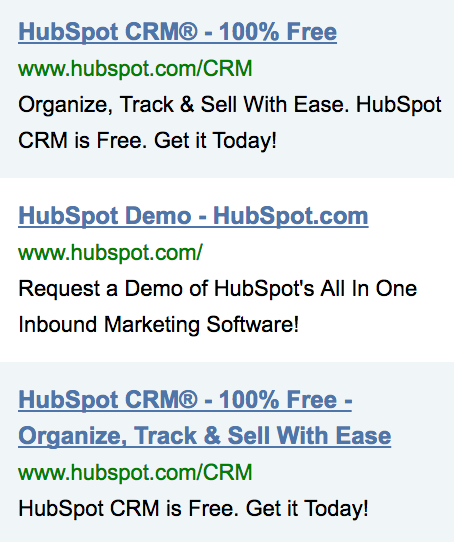
Here is what their entire paid search funnel looks like for their Free CRM offer:
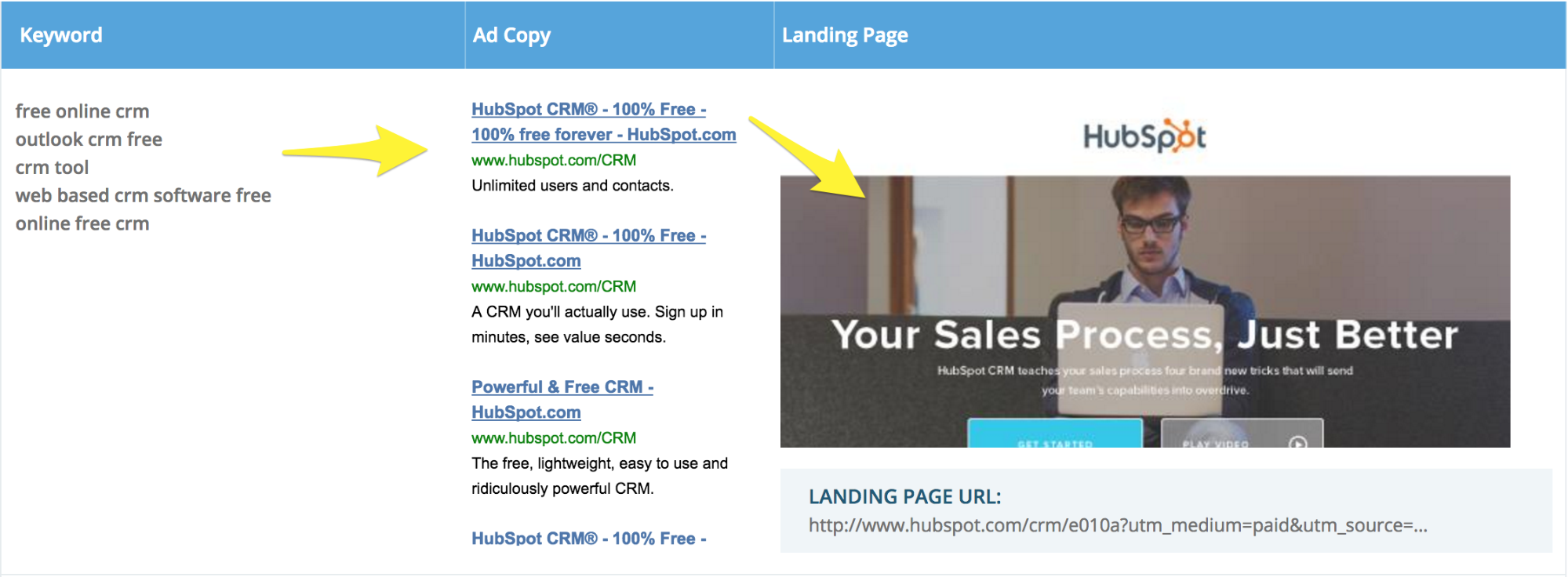
There were a couple of other ads like one with the headline “Free Lead Generation Tool – Start Capturing Leads Today” which were spot targeted ads for a free version of their HubSpot Marketing product.
However, their 3 main active paid search funnels are below and drive traffic to these 3 landing pages:
| SIKAG | Ad Type | Landing Page Type |
| Unbranded CRM Keywords | CRM Ad | Free CRM Offer[*] |
| Branded Inbound Marketing Keywords | Inbound Marketing Ad | Inbound Marketing Assessment Offer[*] |
| Branded Keywords | Demo Ad | Demo Offer[*] |
Golden Nugget: Match your searchers’ intent with your offer using SIKAGs (search intent keyword ad groups). For unbranded CRM keywords HubSpot uses a low-touch, easy to signup Free CRM offer because the searcher likely has no idea who HubSpot is yet.
However for branded keywords, HubSpot uses a high-touch, time intensive Demo offer because the searcher already knows who HubSpot is so they are more likely to get on a call with a sales person.
However for branded keywords, HubSpot uses a high-touch, time intensive Demo offer because the searcher already knows who HubSpot is so they are more likely to get on a call with a sales person.
This is a very mature account and the most recent data in the tool doesn’t represent where they started.
When I look back over the years I can see that HubSpot have tested many different offers including:
- Free Price Quote
- Free 30 Day Trial
- Free Marketing Guides
They have now pruned all but the most profitable keywords and segments over the years and found the best offers that convert for the highest buy-intent keywords in their market. Either that or they are grossly under-utilizing one of the best ad platforms on the Internet (not likely).
The takeaway: Map out the broad categories of keywords your business falls under when people search for your product/service on Google. For every group of keywords come up with an offer that fits your searchers intent and group them into search intent keyword ad groups aka SIKAGs (HubSpot does it with 3 SIKAGs: Unbranded CRM keywords, Branded Inbound Marketing keywords and Branded keywords).
[Tip #8] The 9-Part “Free CRM Lead Generation Page” That Converts Cold Traffic Into Hot, Sexy Customers
This is the above-the-fold section of HubSpot’s Free CRM landing page. It’s important to note that if anyone comes to this page, they can make a quick decision from the info provided in this first section.

Their “Get Started” CTA button leads the visitor to a half lead (email, company name, website URL) form after clicking through.
Everything they need to convert their user is in this section…
1. An image of their “Google Partner Certification” helps instantly add credibility by associating themselves with a big brand name aka Google
2. Emphasis of their headline is about the #1 pain point their market faces (ie: bad sales process)
3. Sub-headline gives people a high-level overview of what the HubSpot CRM does and uses buzzwords that trigger an emotional response with their audience (ie: brand new, tricks and capabilities)
4. A strong call to action in contrasting colours to the background image let people know exactly what the next step is if they’re interested
5. Some people like to read, and some people like to watch. A short 2 min video testimonial from 1 of HubSpot’s customers boosts social proof here
If people want more information before making a decision, they can scroll down and read these 4 points:
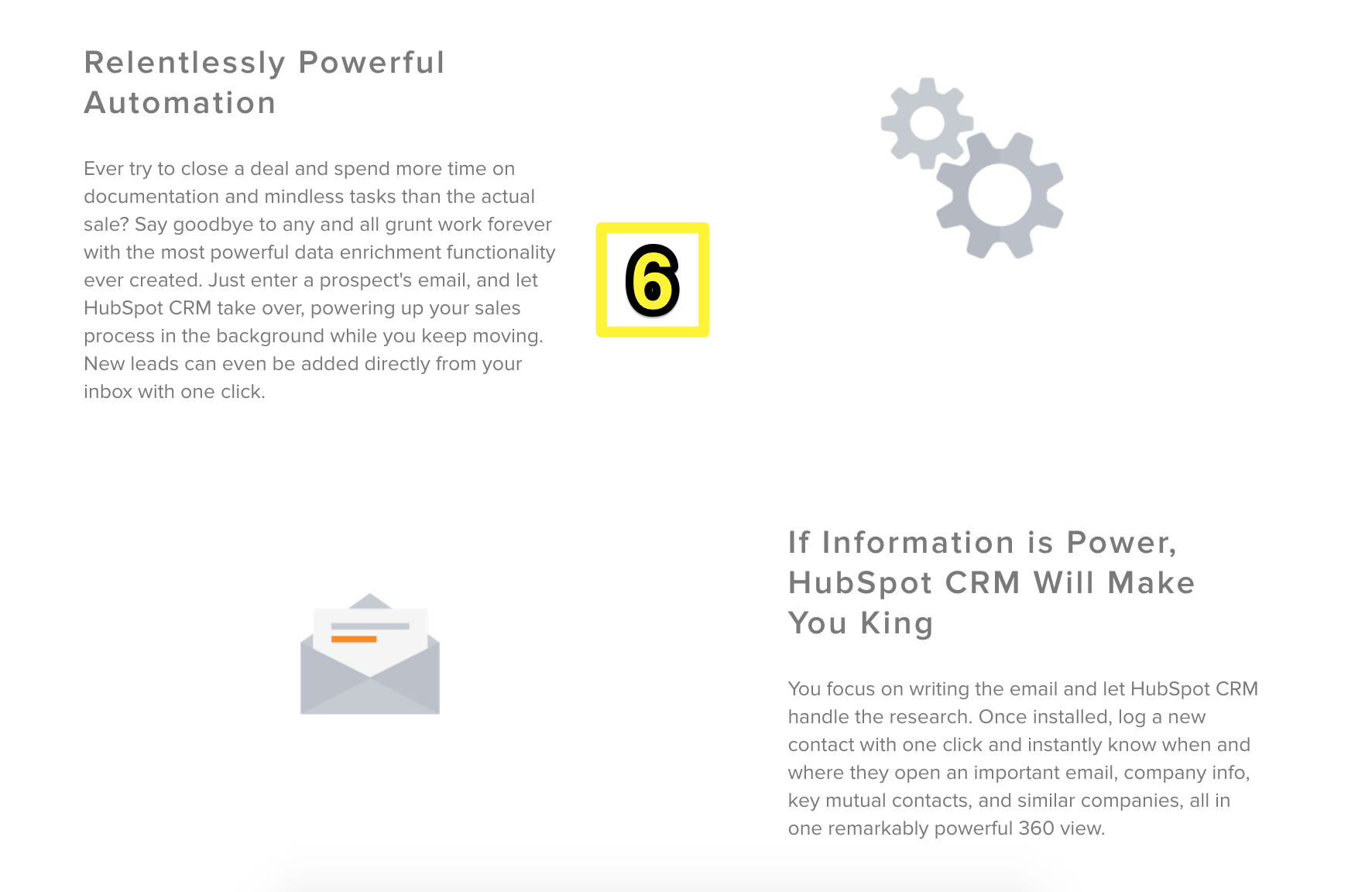
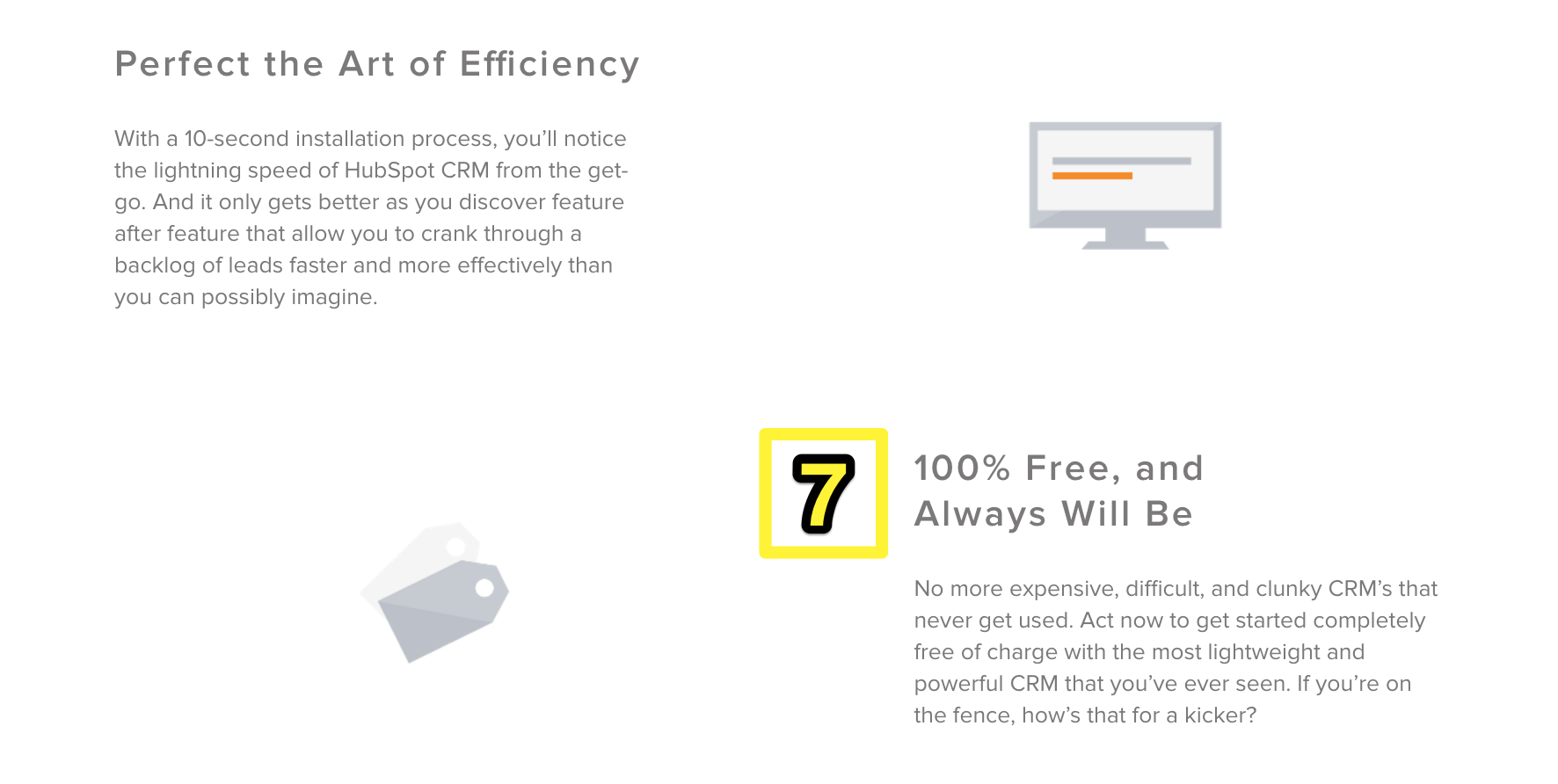
6. The market for CRM software is fiercely competitive. HubSpot know this, so they talk about their key USPs here (like powerful data enrichment functionality, adding leads from your inbox and one customer view) to help people understand if this CRM will be the right fit for them
7. Introducing benefits like ‘10-second installation’ and ‘100% Free’ help to overcome objections people usually have with a product like this
Now people know how HubSpot’s CRM is different from others and the benefits it provides in the 4 points above, they let people know it is just 3 simple steps to get started in the next section:
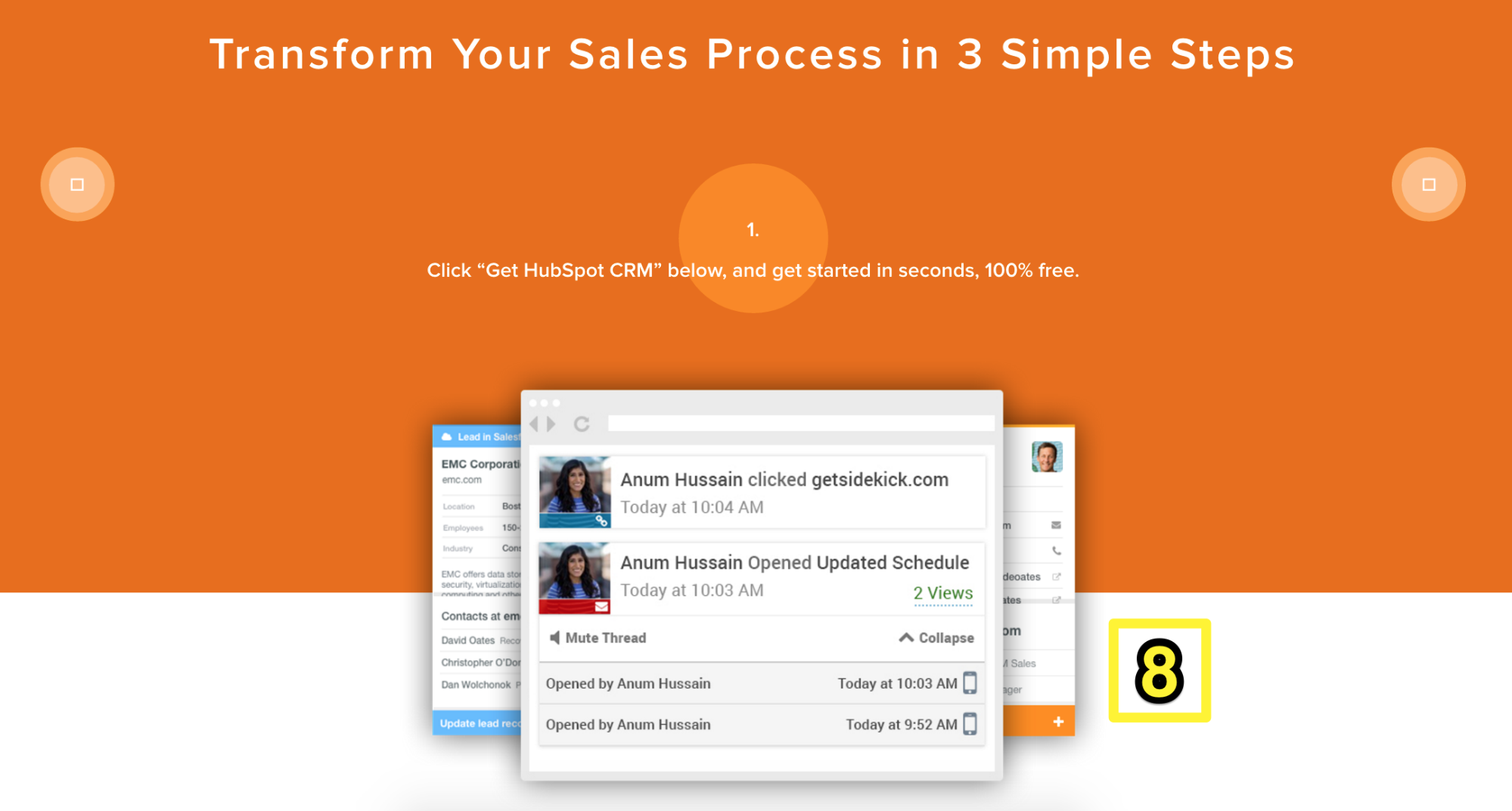
8. Adding a screenshot from inside the software helps people understand what they are going to see when they use the product
Then to round out the page, they have one final CTA:
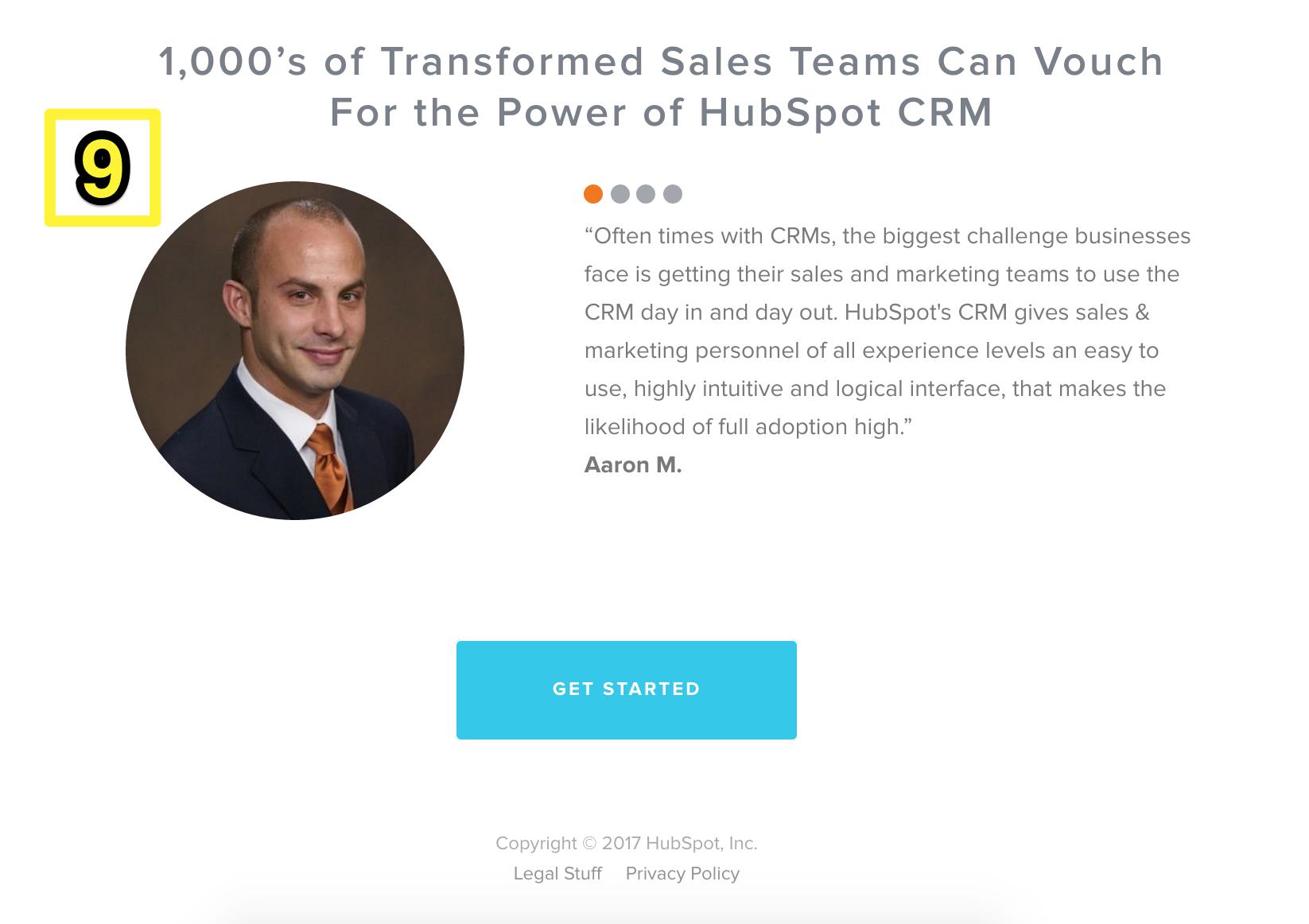
9. It’s been proven over and over again that headshots with short text testimonials right above or below CTA buttons and lead forms increase conversions — use them
The takeaway: Follow this 9-part landing page formula to convert your cold traffic into hot, sexy customers (HubSpot do it with a simple 9-part landing page designed to convert people who have never heard about them before).
[Tip #9] Growth Hack Instagram’s Explorer Algorithm By Partnering With “Micro-Influencers”
HubSpot have a big Instagram following, but not as big as your boi Sumo.

The name of the game when it comes to HubSpot’s Instagram following is simple: “Micro-Influencers”.
According to a HubSpot blogger, here is how it works:
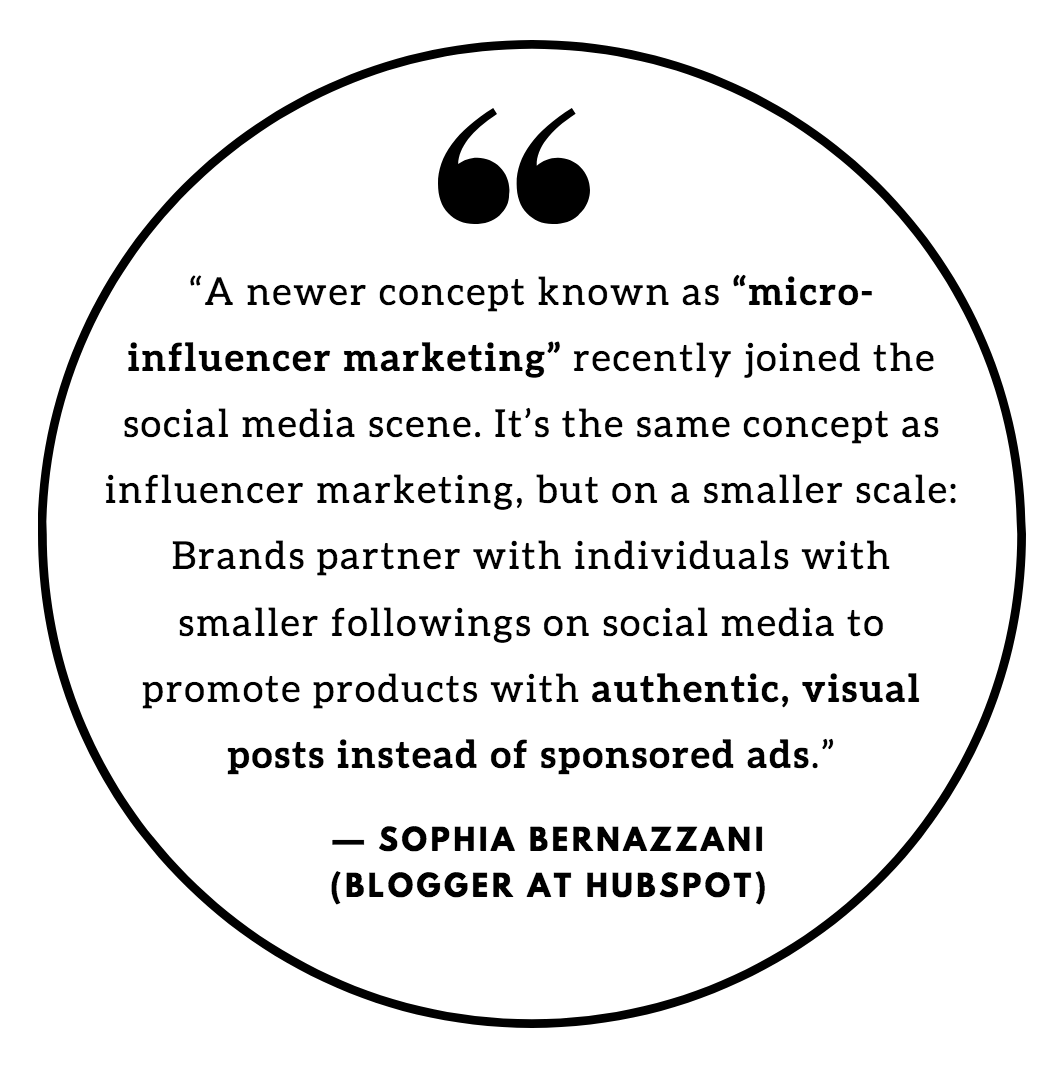
Hubspot uses HubSpot Partners to build a community of micro-influencers.
On Instagram alone you can see over 1600 posts with the hashtag #hubspotpartner. These posts authentically build the following for HubSpot:
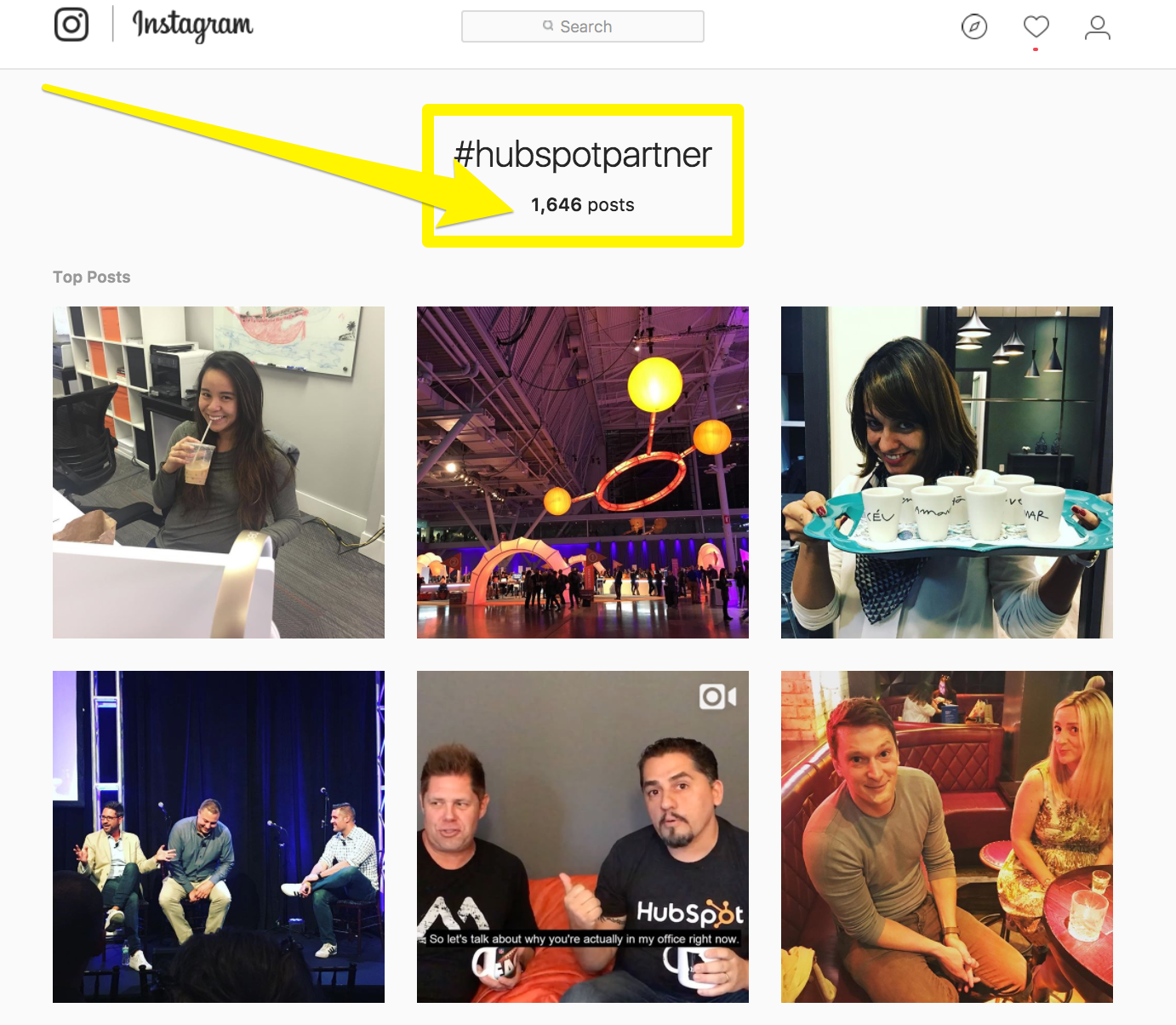
HubSpot also reports that Markerly researched the impact of micro-influencers and their engagement, and found some pretty powerful findings:[*]
- Instagram users with fewer than 1,000 followers generated likes 8% of the time
- Users with 1,000-10,000 followers earned likes at a 4% rate
- Users with 10,000-100,000 followers achieved a 2.4% like rate
- Users with 1-10 million followers earned likes only 1.7% of the time.

Basically, micro-influencers have proven to be highly valuable in terms of the power of the engagement rate of their followers.
The takeaway: Find micro-influencers in your industry on Instagram and give them a hashtag they can use to build social buzz around your brand (HubSpot do it by using their community of HubSpot partners who create and post authentic images/content for them via Instagram using the #hubspotpartner hashtag).
[Tip #10] The “Outbound Sales LTV Growth Hack” That Rewards Your Salespeople For Keeping Customers Longer
While HubSpot clearly has inbound marketing down to a fine art, lots of people like Ed have asked me if HubSpot's growth is due to outbound sales vs inbound marketing.

What is not apparent from the outside is HubSpot’s army of 200+ outbound sales representatives.
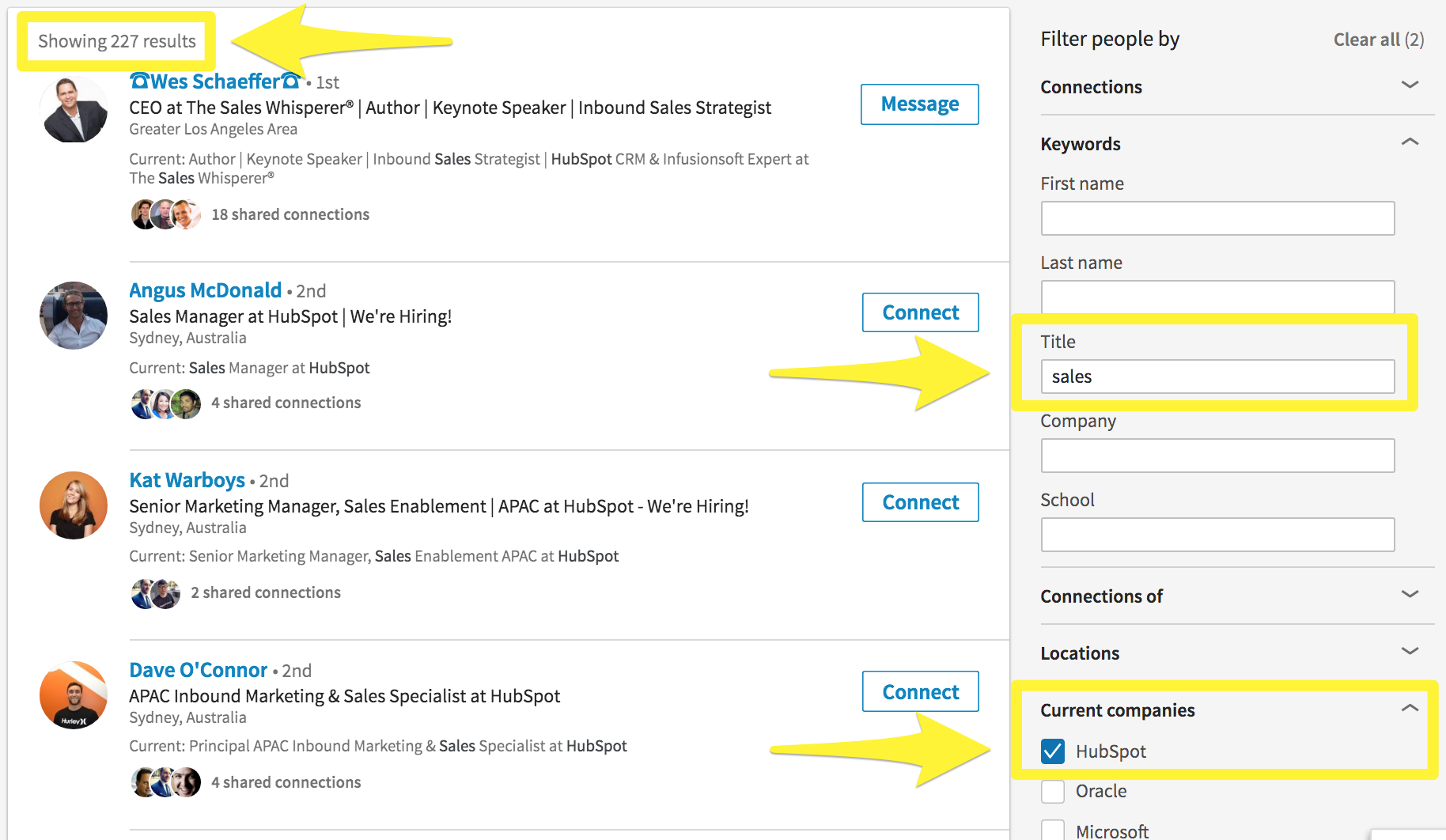
HubSpot have a total of over 2,500 employees, so the sales team make up at least 10% of HubSpot’s total company size.
Outbound sales combined with HubSpot’s inbound marketing prowess is a key part of HubSpot’s success, after all $800+/month software contracts aren’t going to close themselves.
David Skok (one of HubSpot’s investors and Board of Directors) reports the following regarding the strategy HubSpot uses to promote outbound sales within the company:
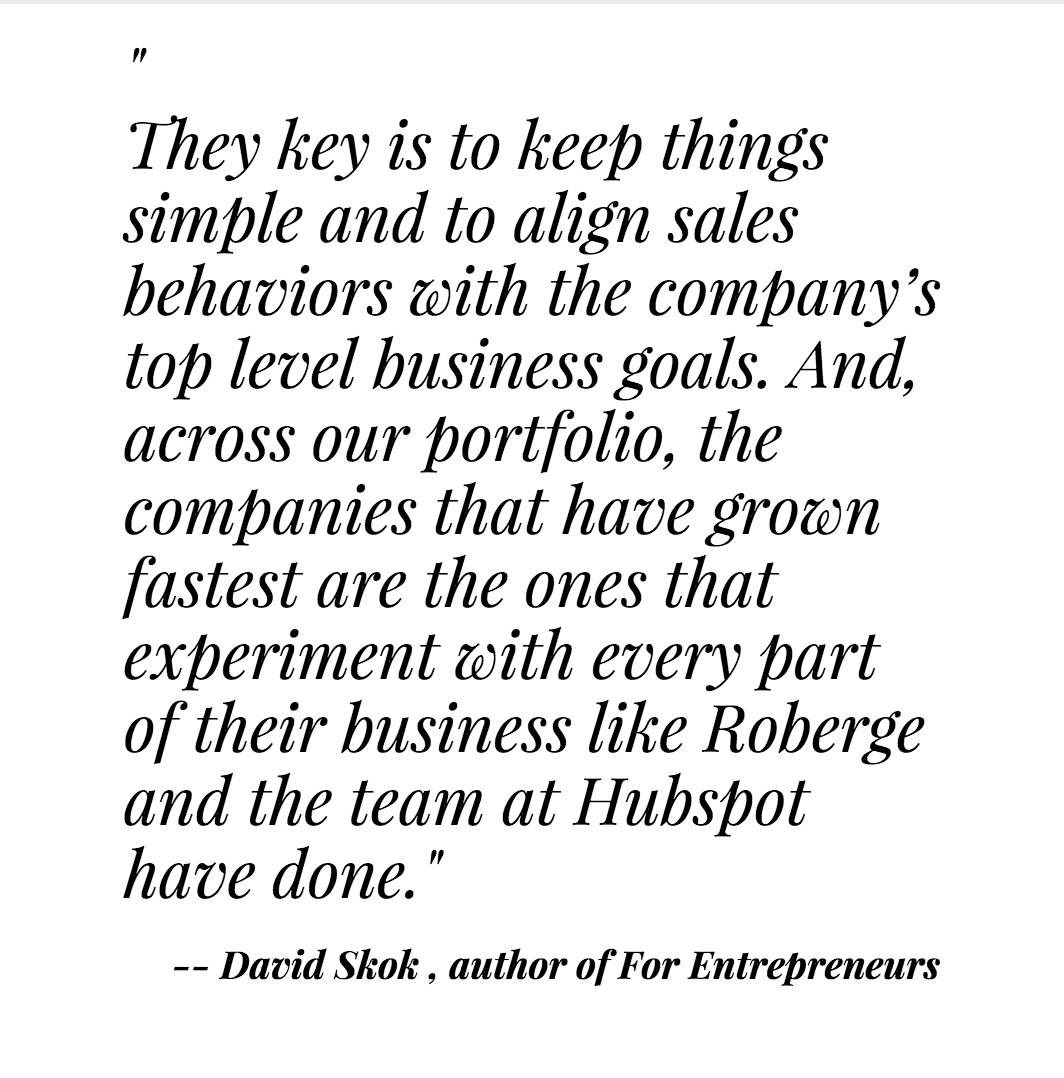
The key difference between HubSpot and many other tech companies, is that HubSpot incentivizes salespeople to retain customers over many years vs. being done when a customer signs a contract.
This helps maximize lifetime value of each customer and was rolled out in the following 3 ways:
- Sales people would lose commission on a sale if the customer cancelled their account within three months.
- Sales people were given a small percentage of each customer's monthly fee to encourage salespeople to help with client retention throughout the lifetime of that customer (and not just the first few months).
- HubSpot rolled out non cash based incentives through different internal contests. An example of one of these contests would be the team would all ride in a limo if a goal was met. These goals were often ‘team based’ encouraging salespeople to work together.
These 3 things put HubSpot salespeople in a position to be incentivized to help the company reduce churn and increase revenue.
HubSpot’s sales team is so successful that HubSpot built a Free CRM small businesses can use to grow their own sales, based on the processes the HubSpot sales team uses to organize, track and nurture their leads and customers.
Click here to reveal HubSpot's Free CRM tool.
The takeaway: If you sell a high price point product, complement your inbound marketing efforts with outbound sales. Make your salespeople a big part of customer retention by aligning their sales commission with the duration of a customer's lifetime vs. just when the contract is signed (HubSpot do it by deducting sales commissions if a customer churns within 3 months, giving a recurring commission if customers stay longer than 3 months and paying for team activities if team goals get hit).
[Tip #11] The Proactive Customer Happiness Dashboard That Uses Your Customers Behavioral Data To Kill Your High Churn Rate
HubSpot’s Customer Happiness Index (CHI) was created by Jonah Lopin, HubSpot’s former VP of Customer Success.
CHI is also a play on words from the chinese word CHI meaning life force. This one metric uses customers behavioural data to give you a CHI score for every customer, and is now HubSpot's #1 tool for killing churn.
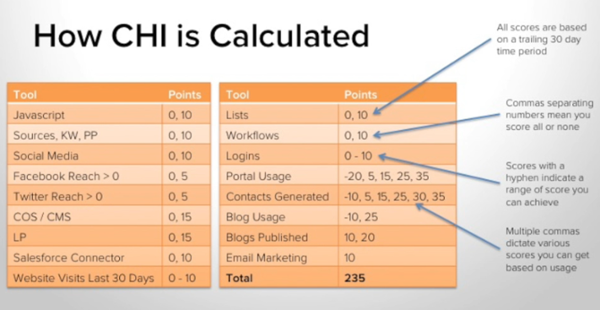
HubSpot focuses on getting as many data points as possible for each customer based on actions they have taken inside their product.
Then they create a regression analysis on the data to find which customers are going to churn before they do.
Here is an example of what this looks like:
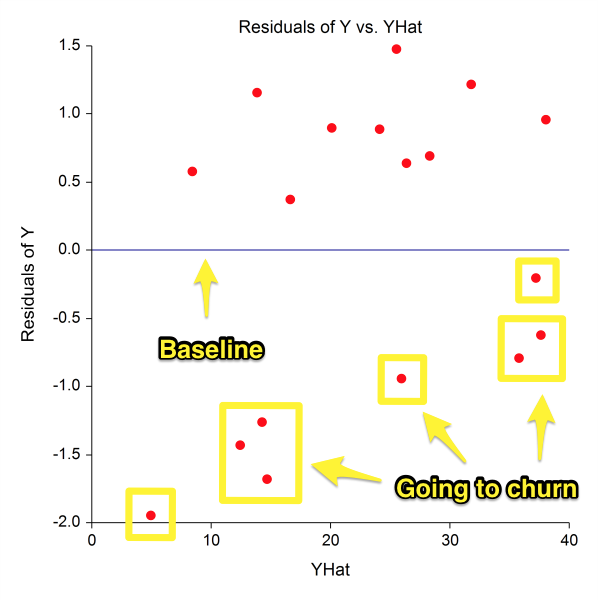
With CHI, Dharmesh (HubSpot’s founder) has the ability to determine if a customer is going to churn in 1 month, 2 months or even 4.2 months time, then get his team to reach out to them ahead of time.
Most companies have been taught that you need to measure your customers Net Promoter Score (NPS), by sending out emails like this:
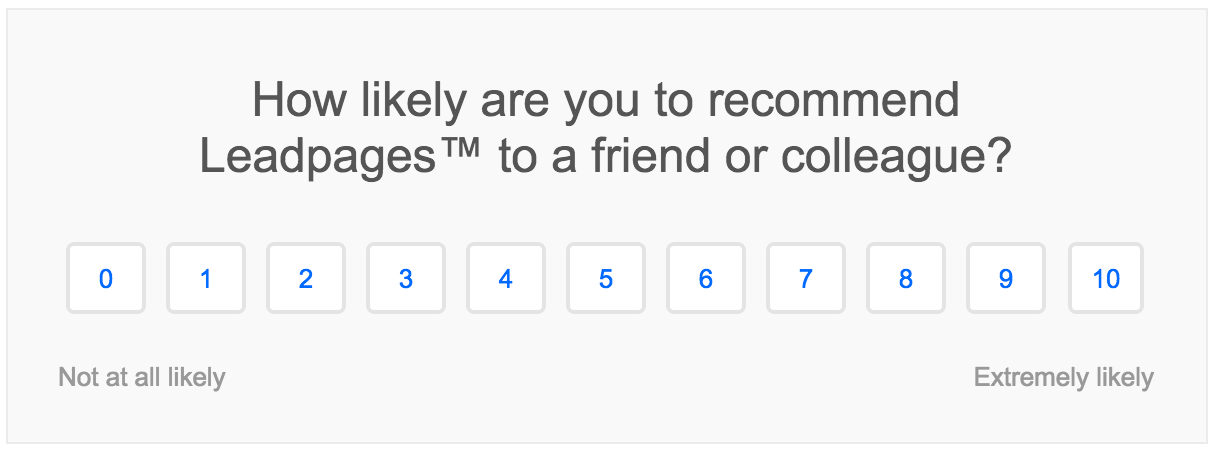
However NPS only measures qualitative data, and the NPS of your customer now vs one month later could be completely different based on their interaction with your product.

Instead, HubSpot uses CHI to measure what customers are actually doing with their product so they can see if customers are doing better or worse than the baseline they have determined.
Customer Success managers are also able to use CHI to see if their customers are on par for reaching their goals.
The takeaway: "Don't ask people what they think. Watch what they do." This is the advice Dharmesh has for businesses wanting to find out if a customer is about to churn aka leave your product (HubSpot do it by calculating a Customer Happiness Index based on every customer's behavioural data so they can reach out to them before they churn).
[Tip #12] Build A Free Software Tool That Surfaces Your Customers Problems, Then Shows You Are The Solution
HubSpot’s free Website Grader tool was the first ever project to come out of HubSpot Labs in 2007. A person enters their website URL and email address to see how strong their website is out of a score of 100.
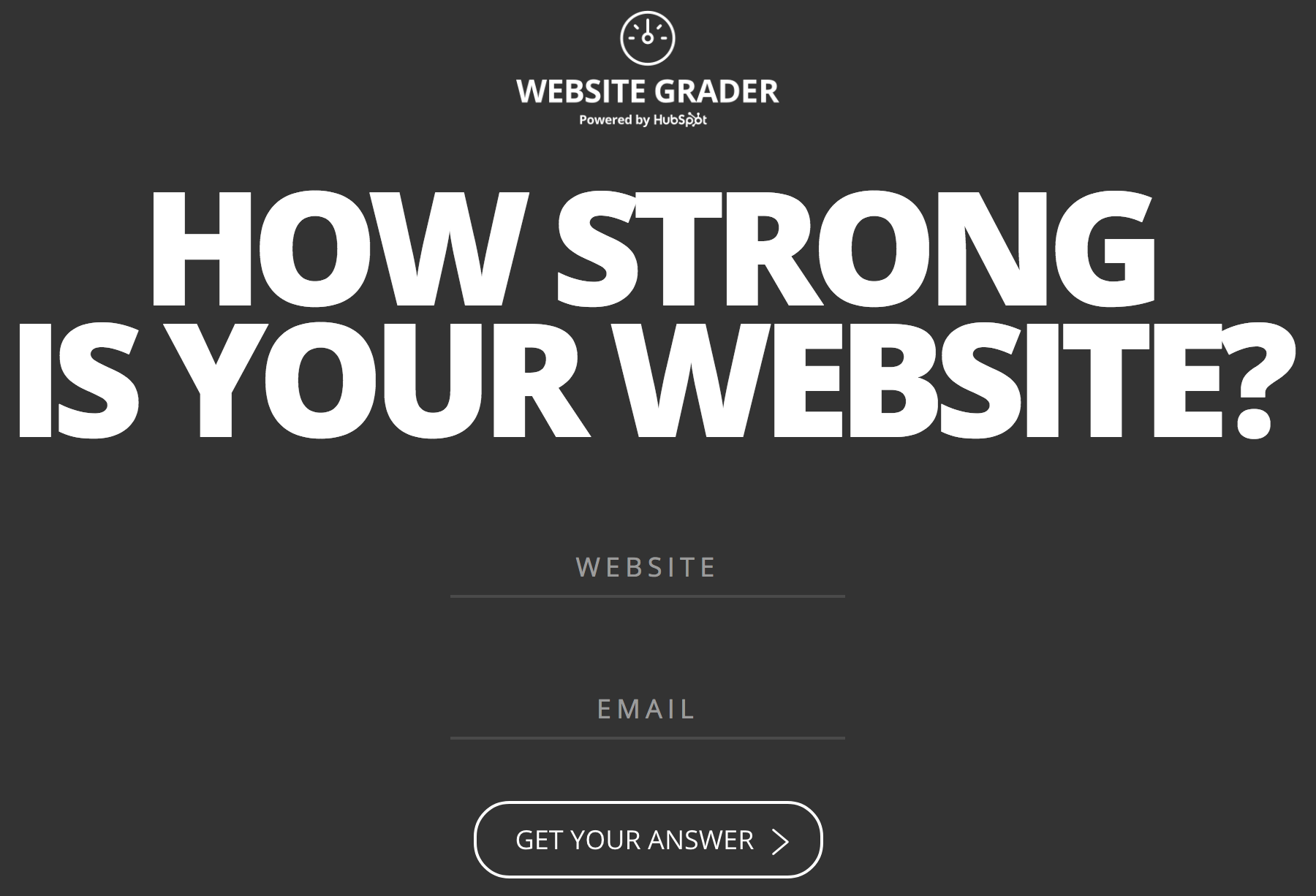
Here is what my website grade looks like:
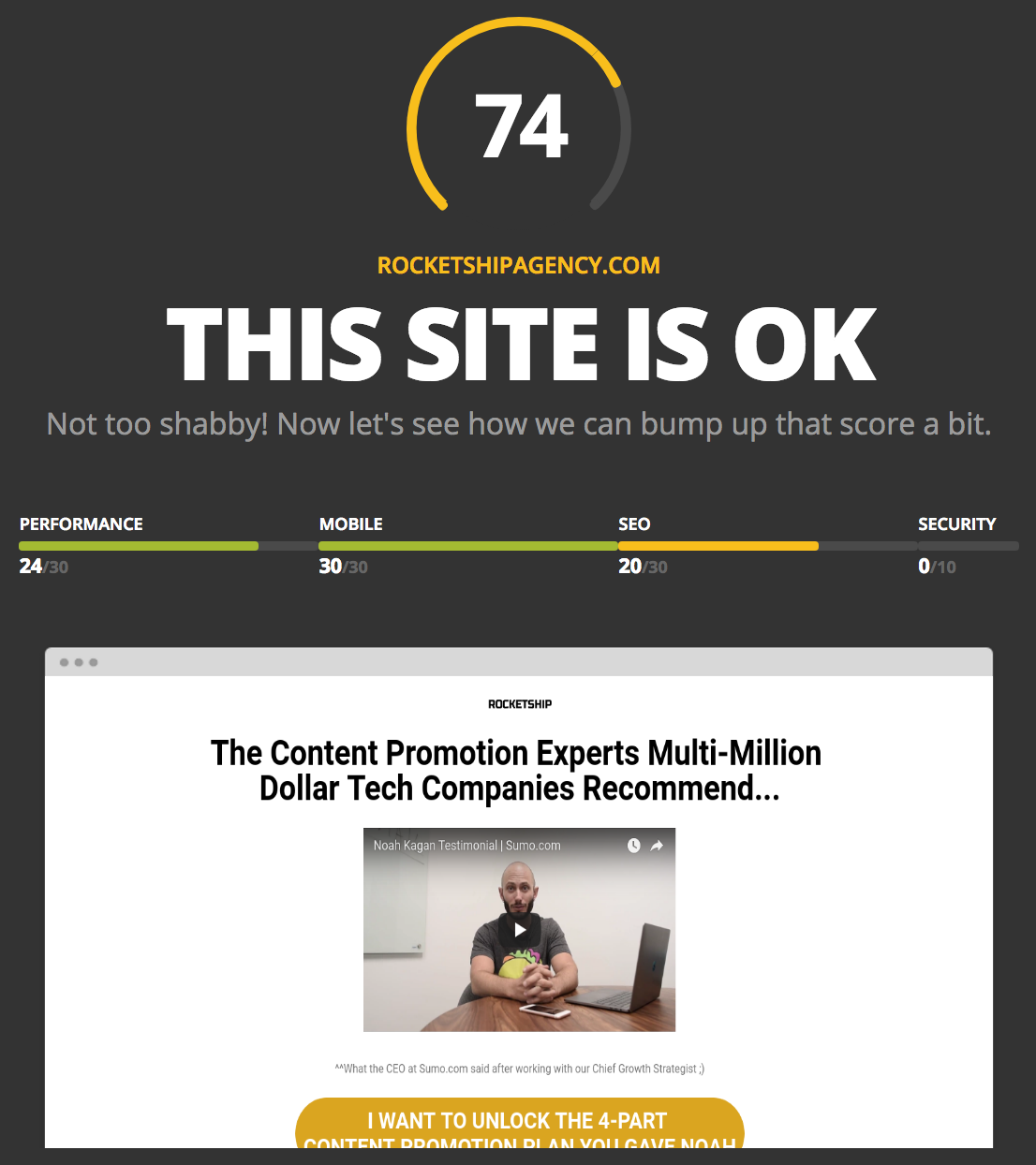
You then get recommendations on what you need to improve when it comes to:
- Performance (30 points)
- Mobile Readiness (30 points)
- SEO (30 points)
- Security (10 points)
HubSpot are smart, because under every website grading element they have a call-to-action that says “READ MORE >” which links to an educational article on their blog about how you can fix it. #valuebombing
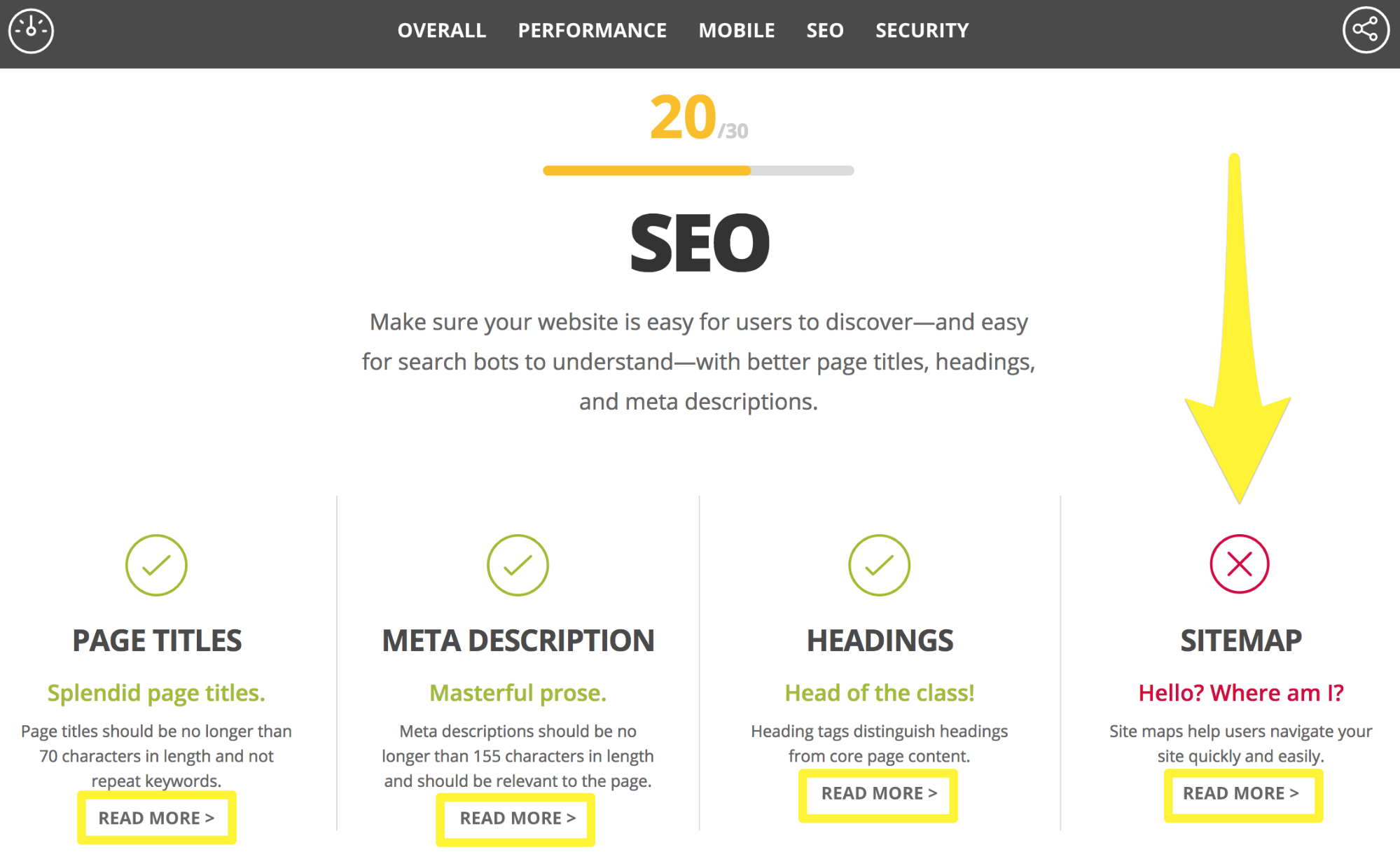
But it gets even better. HubSpot give you a summary of what you should do next at the bottom of the page and provide their software as the solution if you don’t want to waste your time doing it all yourself:

Golden Nugget: After you surface your customers’ problems, show you are the solution (HubSpot surfaces all your website's problems and then shows they are the solution to make “your site faster, mobile responsive, and secure automatically”.)
Aside from being a super helpful tool for small business owners, it is also a great example of how to build a free tool to drive millions of market specific TOFU (top-of-funnel) leads to your company.
Dharmesh posted on Inbound.org about how significant the tool has been to HubSpot’s success…
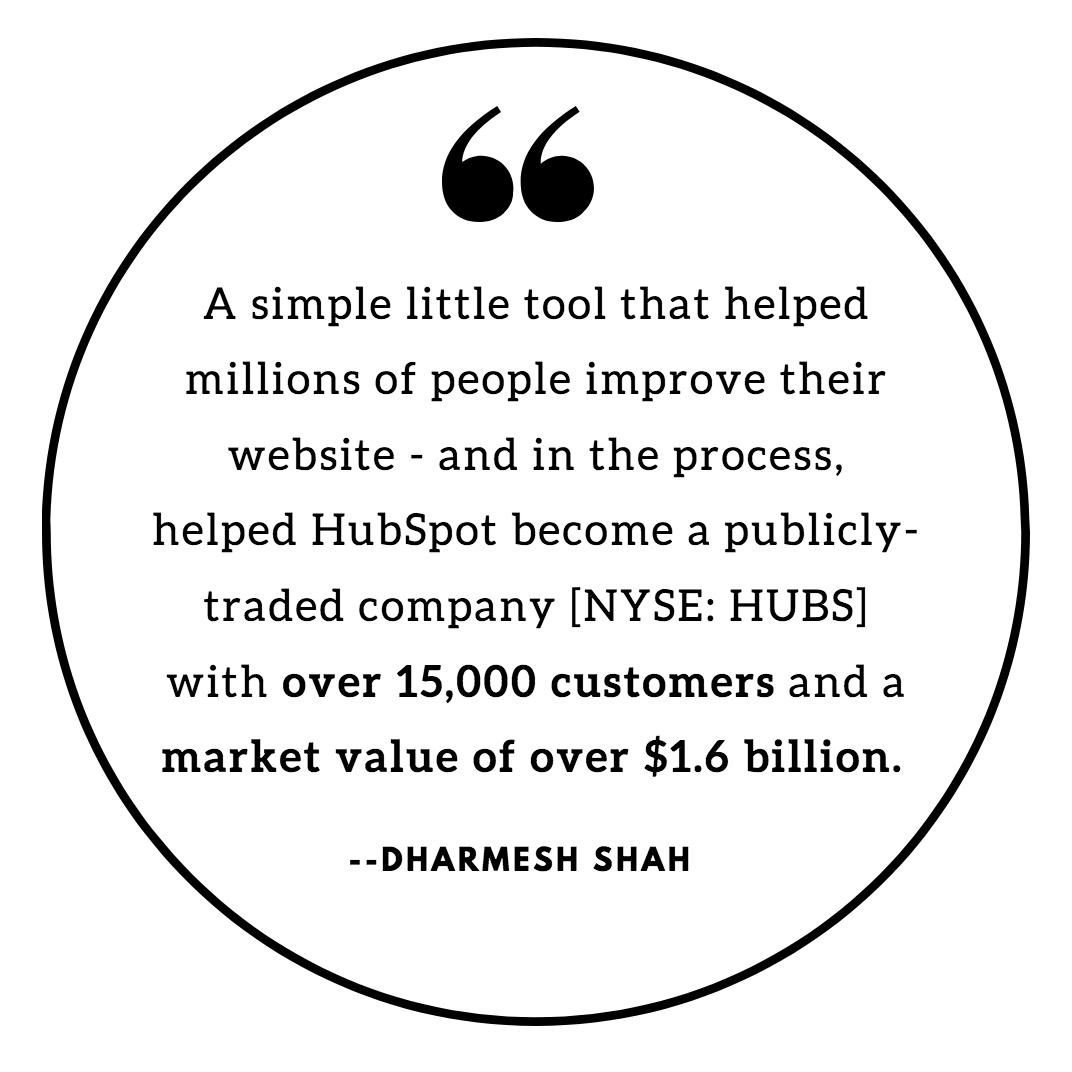
The majority of website traffic for the tool comes from the HubSpot blog, suggesting that blog content combined with a strong market specific lead magnet can be a great combination to acquire TOFU leads at scale.
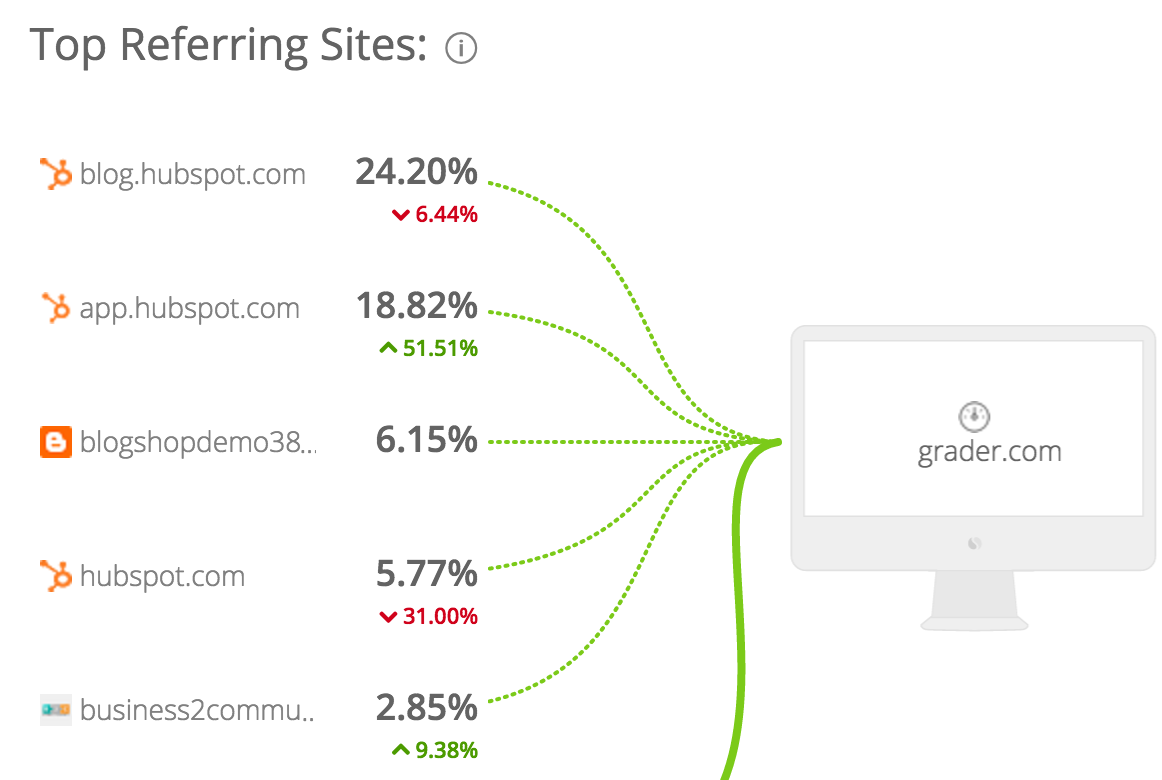
Since their success with Website Grader, HubSpot have got ultra-granular with their TOFU lead generation. They now create blog posts with blog post specific lead magnets on their main website to fill the top of their sales funnel with thousands of leads every month.
The takeaway: Build a free software tool that can surface your customers’ core problems. Then give them recommendations on how to solve the problems themself or use your product as an easy solution (HubSpot do this with their free Website Grader tool that surfaces your website problems, provides recommendations and offers their product as an easy solution).
[Tip #13] The Facebook Fan Page Messenger Bot That Generates Leads On Autopilot
HubSpot’s genius marketing machine is focused on creating lead magnet opportunities wherever possible, and using a Facebook Messenger bot on their Facebook fan page is another way they generate new leads:

When you click on that blue “Get Started” button, here is what you see:
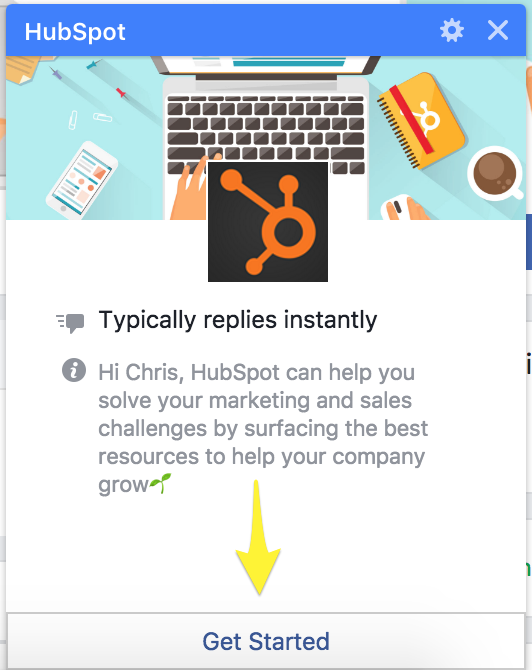
If you confirm that you want to “Get Started” then HubSpot’s Facebook Messenger bot will send you this welcome message:
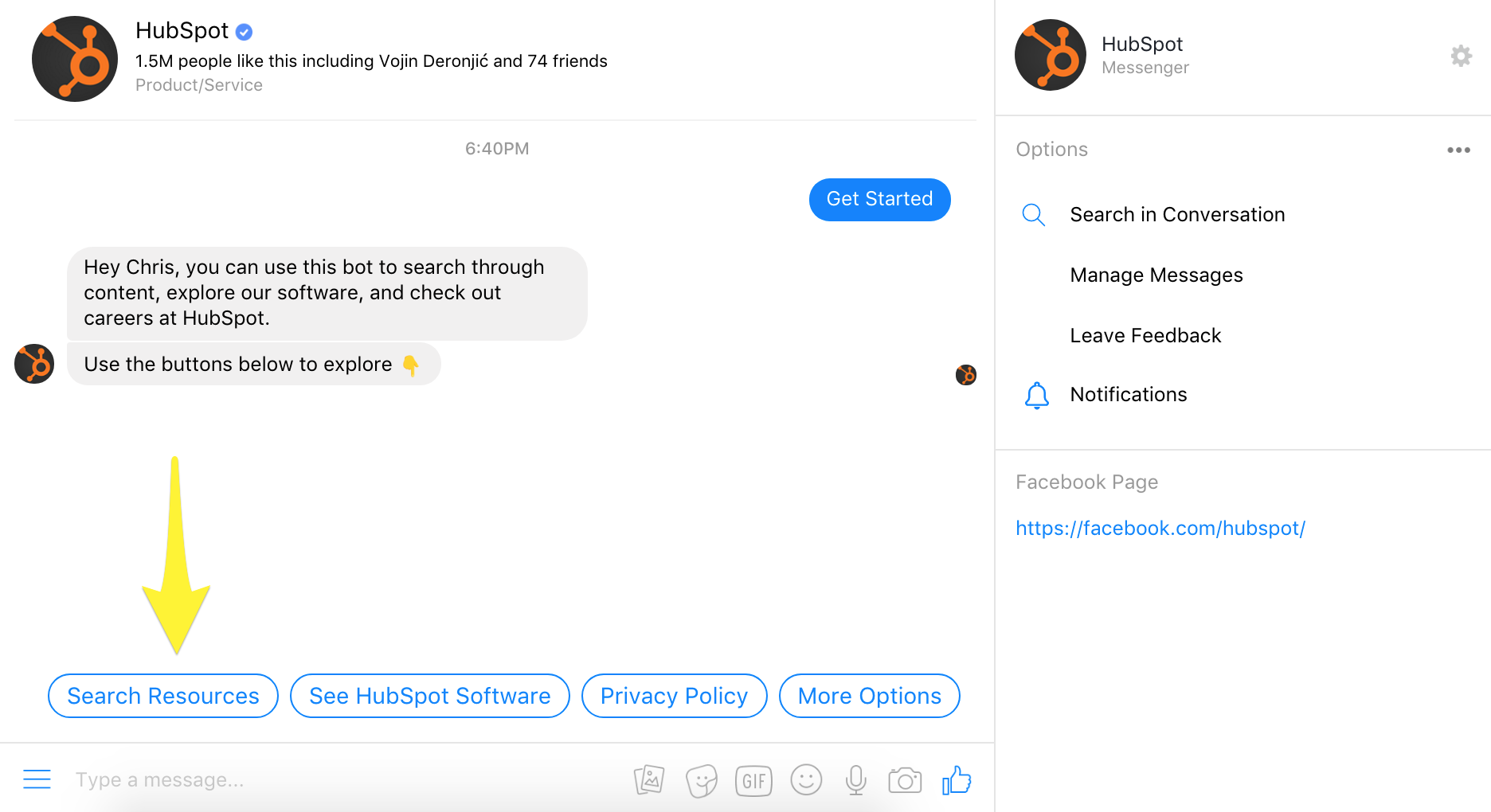
If you click on the first option “Search Resources”, the bot gives you three calls-to-action for you to choose whether you want to search the blog, search eBooks or subscribe to HubSpot content via Facebook messenger:

Click here to reveal the Facebook Messenger Bot tool HubSpot uses.
The two most interesting options are “Search Ebooks” and “Subscribe to Content”. Subscribing to content is how HubSpot are building a Facebook Messenger list (in addition to their email list)!
Why should you do this?
Because Facebook Messenger average open rates are over 80% compared to email that has an average open rate of just over 20%.
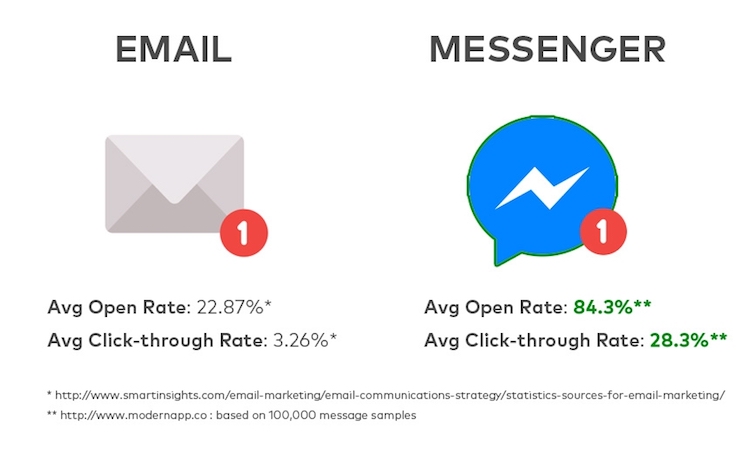
That’s 4X more people opening your messages and 9X more people clicking on your content!
But HubSpot doesn’t stop there. If you click on “Search Ebooks” you are guided to search their eBook selection on any marketing topic you can imagine!
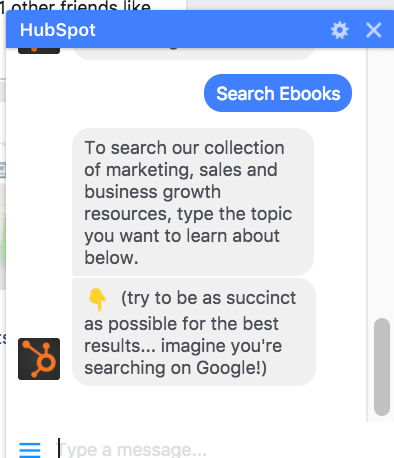
Then you are authentically guided to that free resource:
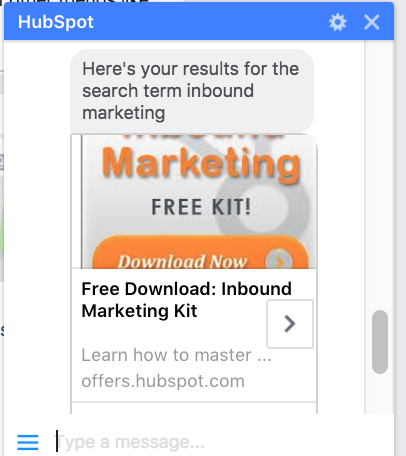
Which then serves as a lead magnet:
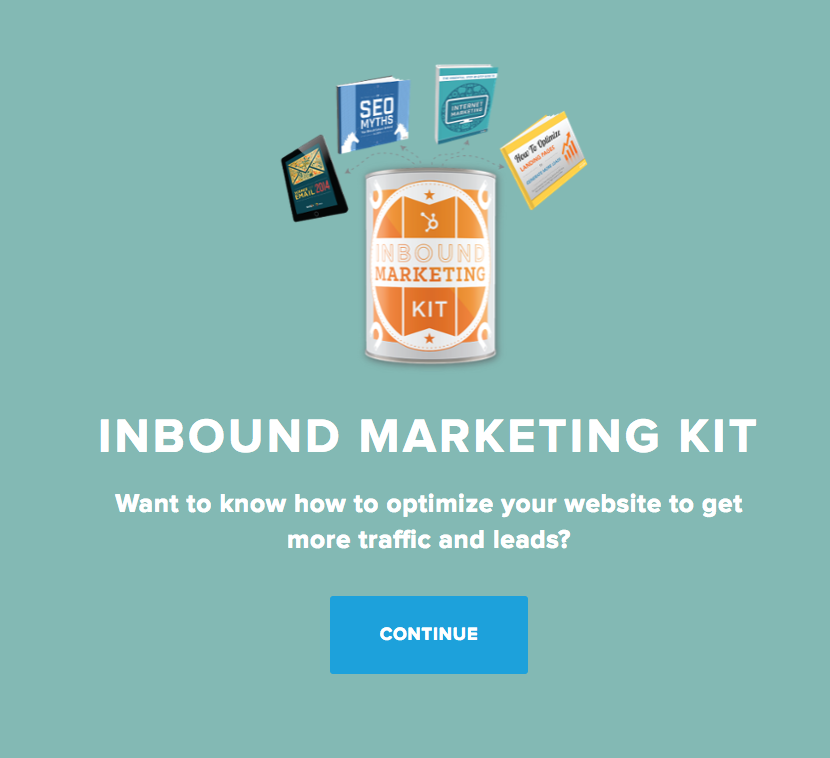
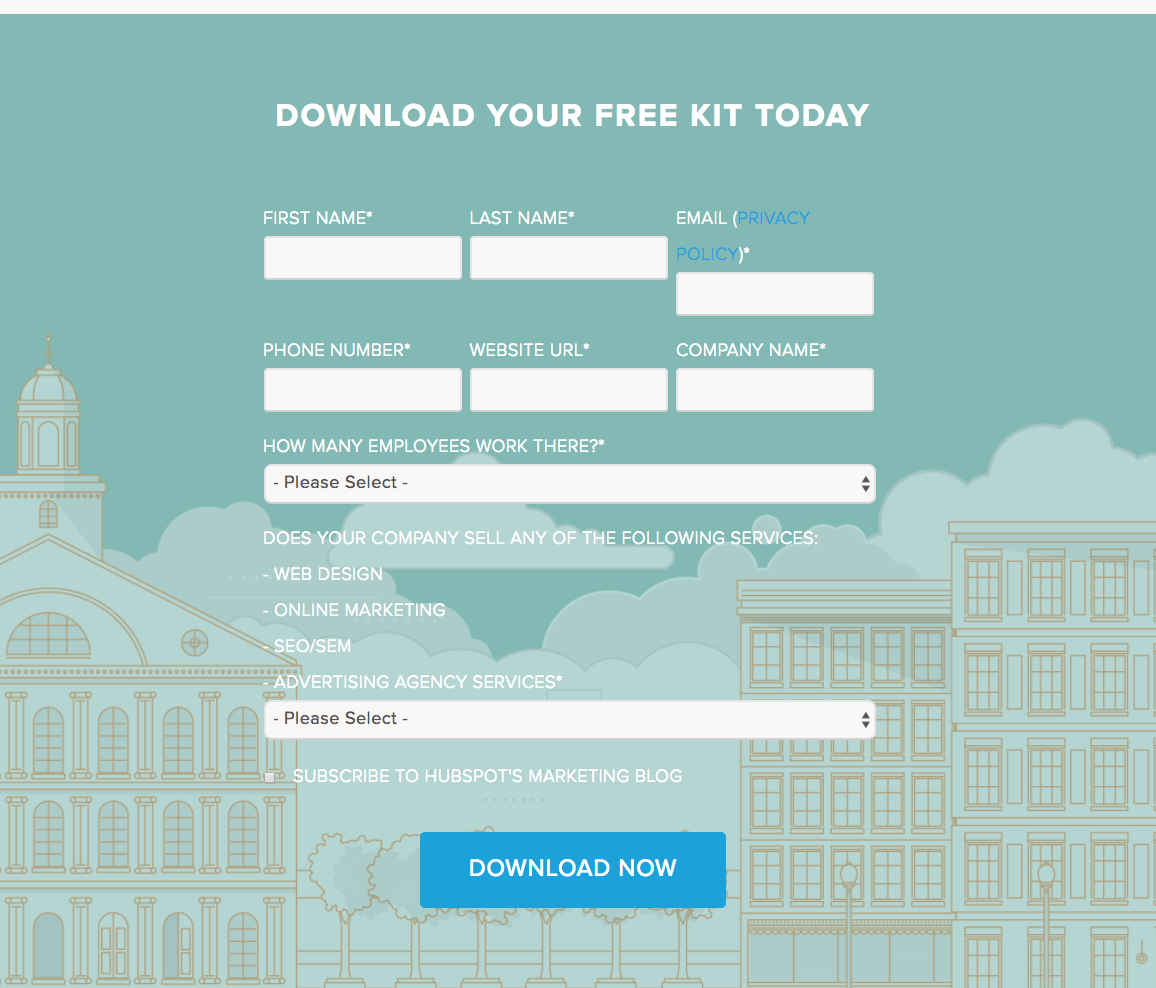
The takeaway: Use a Facebook Messenger bot on your Facebook page to build a Facebook Messenger list and create another source of leads for your business by connecting your lead magnets as free resources based on which topic your visitor searches for (HubSpot do it so they have multiple channels to communicate with their customers, collect more leads and take advantage of 80%+ open rates on FB Messenger).
13 Key Takeaways From HubSpot’s Multi-Million Dollar Marketing Strategy
HubSpot have some unconventional growth strategies that have been the driving force behind their consistent growth.
Here are the 13 key takeaways:
- Partner with the top dogs from related industries to create a powerhouse content partnership offering that your prospects can’t resist.
- Boost your B2B prospects with LinkedIn’s sponsored ads. Use LinkedIn’s high quality audience to promote content relevant to your potential customers, and incentivize them to engage further with you by offering a relevant lead magnet on the content you are promoting.
- You can’t just offer loads of free blog articles and expect those visitors to convert into customers. Instead, use your blog to also link to high-value free downloadable guides that grow your email list, and offer intuitive ‘next step’ CTA’s to entice visitors into a deeper conversation with you and frames you as the industry expert.
- Research high value marketing topic keywords, then use these to create your content calendar + create one content-upgrade per blog post (HubSpot uses 3 CTAs that link to their content upgrade to grow their email list with every piece of content they write).
- Create relationships with top influencers in your industry. Attract them to guest blog for you by sharing your audience with them, or incentivising them in some other way.
- Don’t underestimate the power of communities and connecting your customers with each other. Leverage your customer and industry partner’s knowledge to learn from one another.
- Don’t overlook the broader categories of PPC keywords that your business falls under. Research the intent behind these broader categories and create offers that match (Hubspot uses 3 broad categories: Unbranded CRM keywords, Branded Inbound Marketing keywords and Branded keywords).
- Follow HubSpot’s proven 9-part landing page formula to increase the conversion rate of your cold traffic, and allowing you to more quickly turn them into hot-sexy customers.
- Target micro-influencers on Instagram by uniting them around a common hashtag to encourage authentic promotion from them.
- Get your salespeople to be a part of your customer retention by aligning their commission with the duration of the customer's lifetime and not just the initial sale (HubSpot deducts sales commission if a customer leaves with 3 months, and also incentivises sales people by offering a recurring commission if a client stays on longer than 3 months.
- Collect every bit of data you can about your customers to predict a customer’s next move before it happens. Use this information to create tactics that stops churn before it happens (HubSpot calculates a Customer Happiness Index on every customer's behavioural data so they can step in and stop churn before it happens).
- Build a free software tool that can surface your customers core problems. HubSpot uses their free CRM to address their customer’s core problems, then they offer their free website grader to give their customers the guidance to address their specific issues.
- Build a Facebook Messenger list by using a Facebook Messenger bot on your Facebook fan page. This list will serve as another source of lead generation for your business (HubSpot uses this to grow the ways they communicate with their customers, to collect more leads, and to benefit from the 80%+ open rate on Facebook Messenger).
If you are in the same market as HubSpot, you certainly have your work cut out for you. However, I hope this brief has helped you to see what areas they are strong in and where they might be weak.
If you are not in the market you should be thinking about how you can apply what they are doing to YOUR business, in YOUR market.
You should not be thinking my business is different so none of this applies. Trust me after having worked with many high-growth startups — no business is that different. These strategies work in all business markets.
Also, take notice as to what is not here. The strategies they are and aren’t using is important to identify.
What strategies and tactics are not showing up here that some experts say you MUST be doing. I find it much more effective to learn from what’s actually in play and working with the biggest players, than trying to guess.
Double-down on what works. Ignore everything else. It is just a distraction.
The first version of this growth study was originally published on Rocketship Growth.
Related Articles
%(relatedarticles)
Add A Comment
VIEW THE COMMENTS